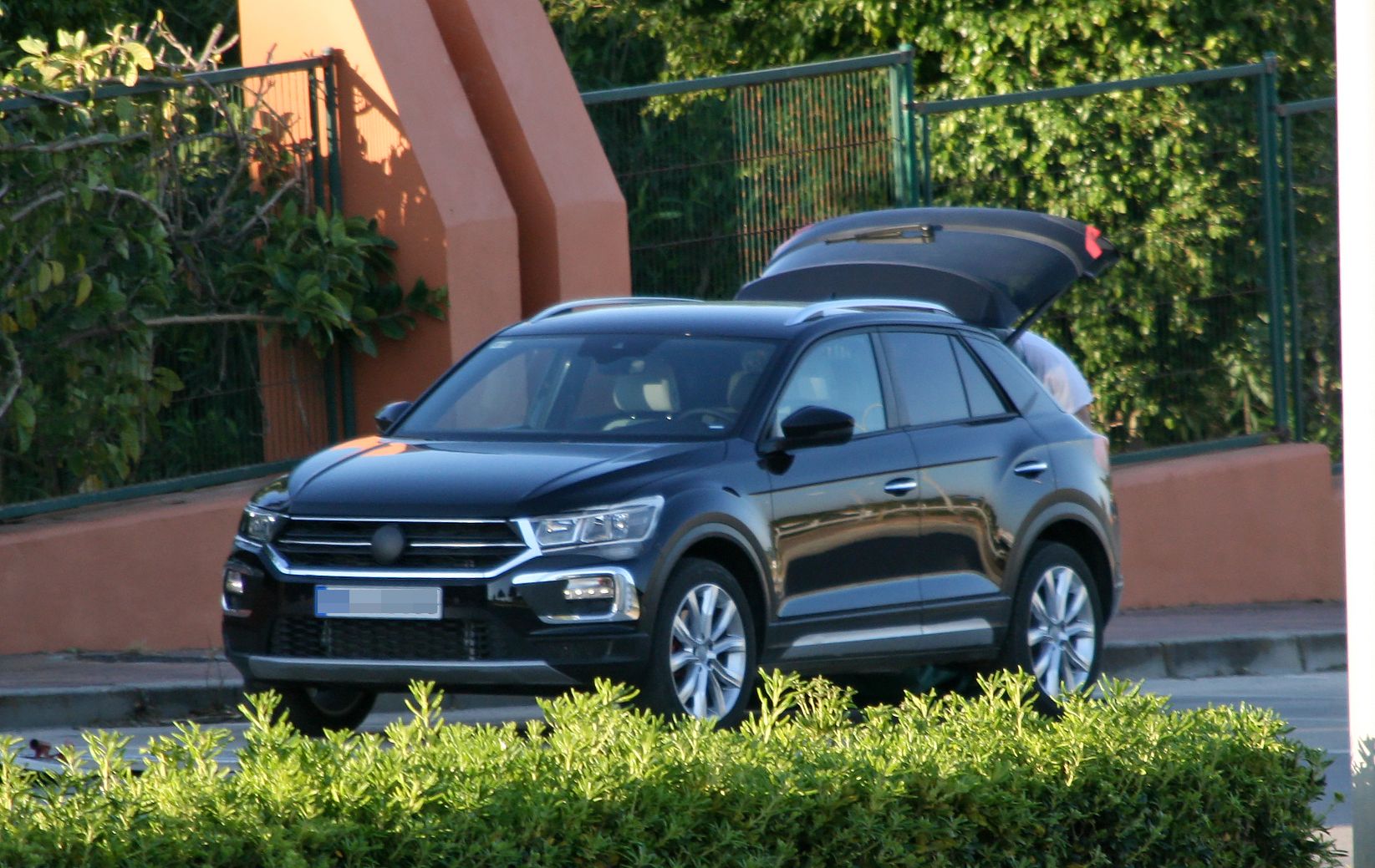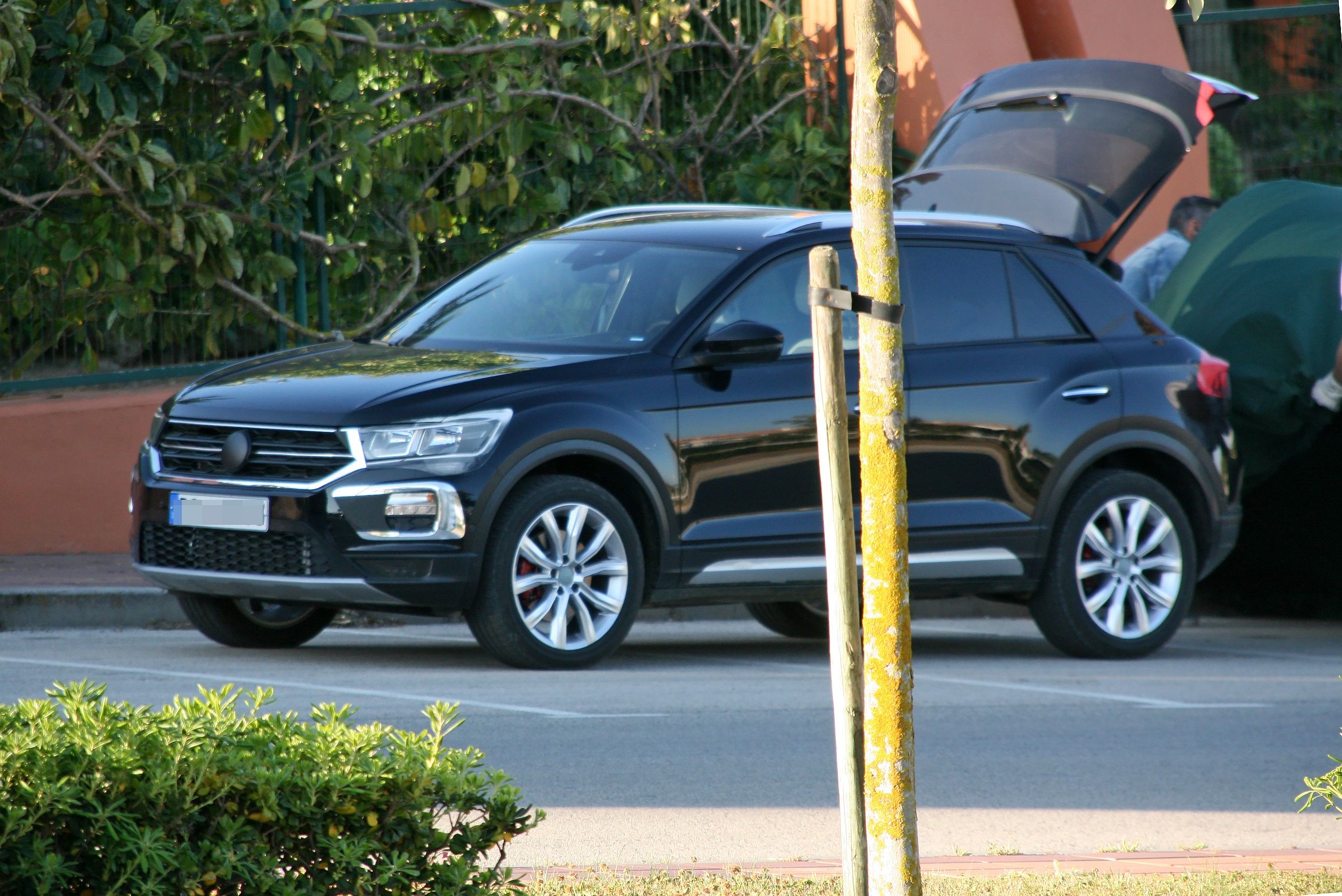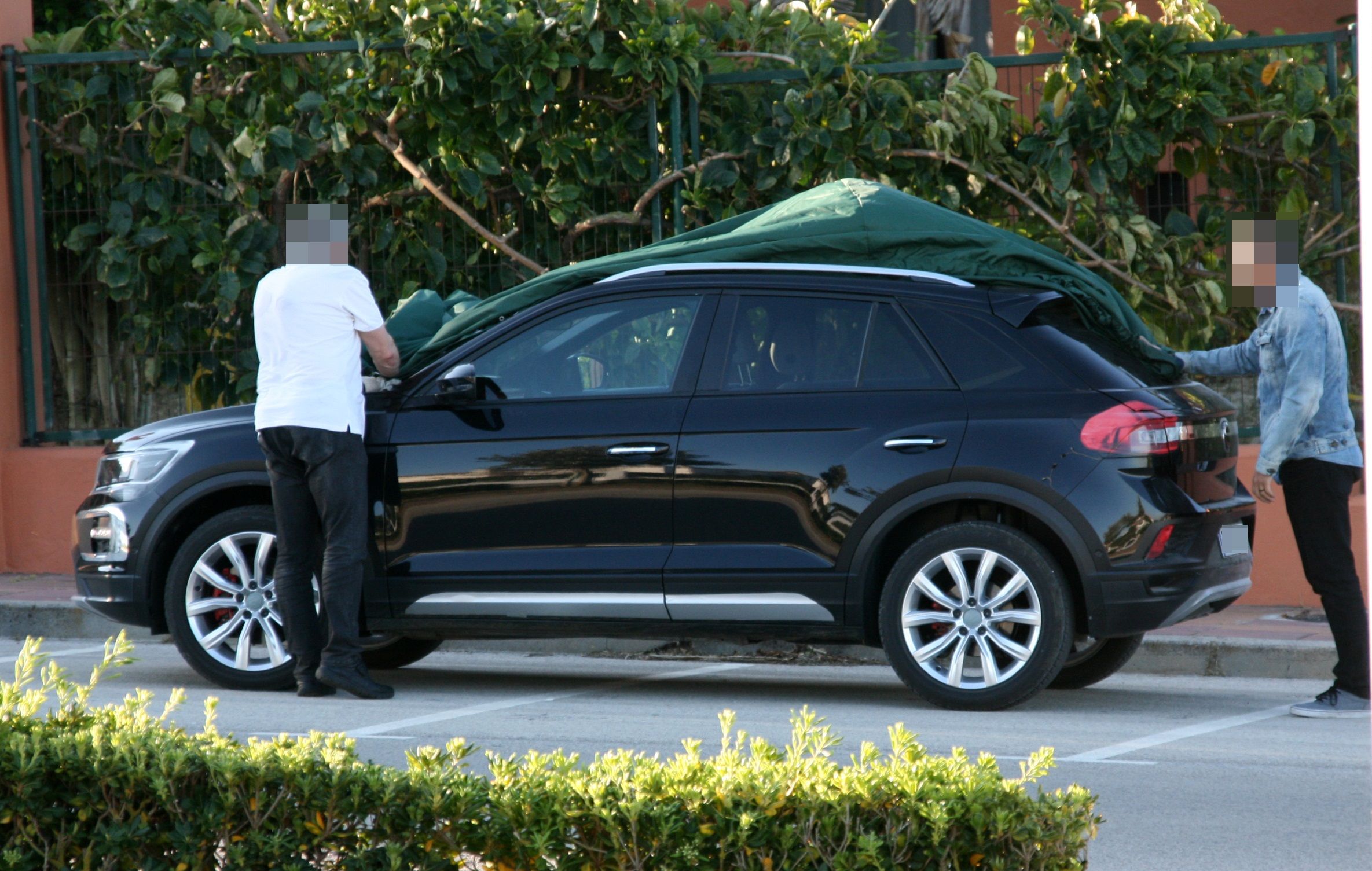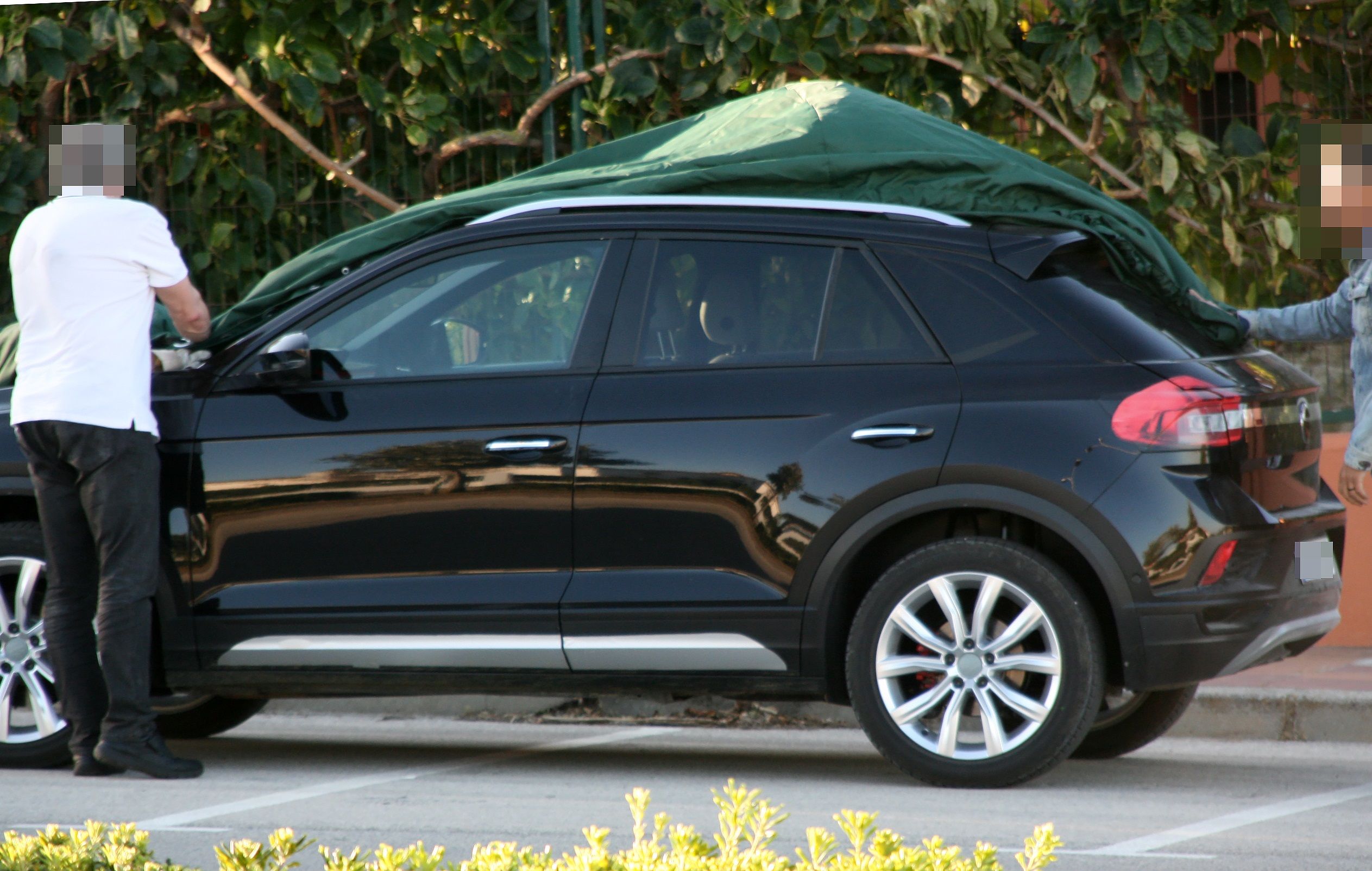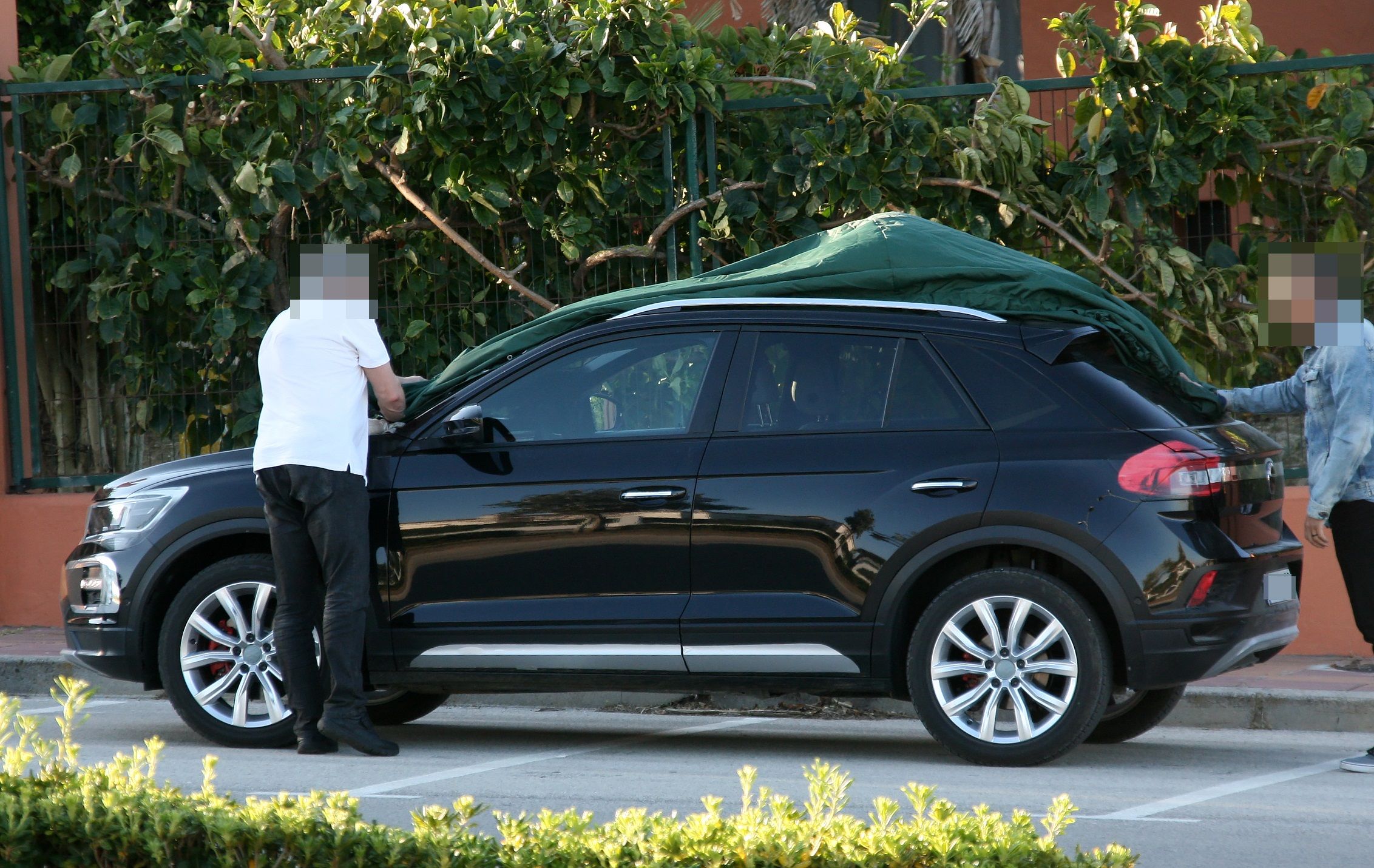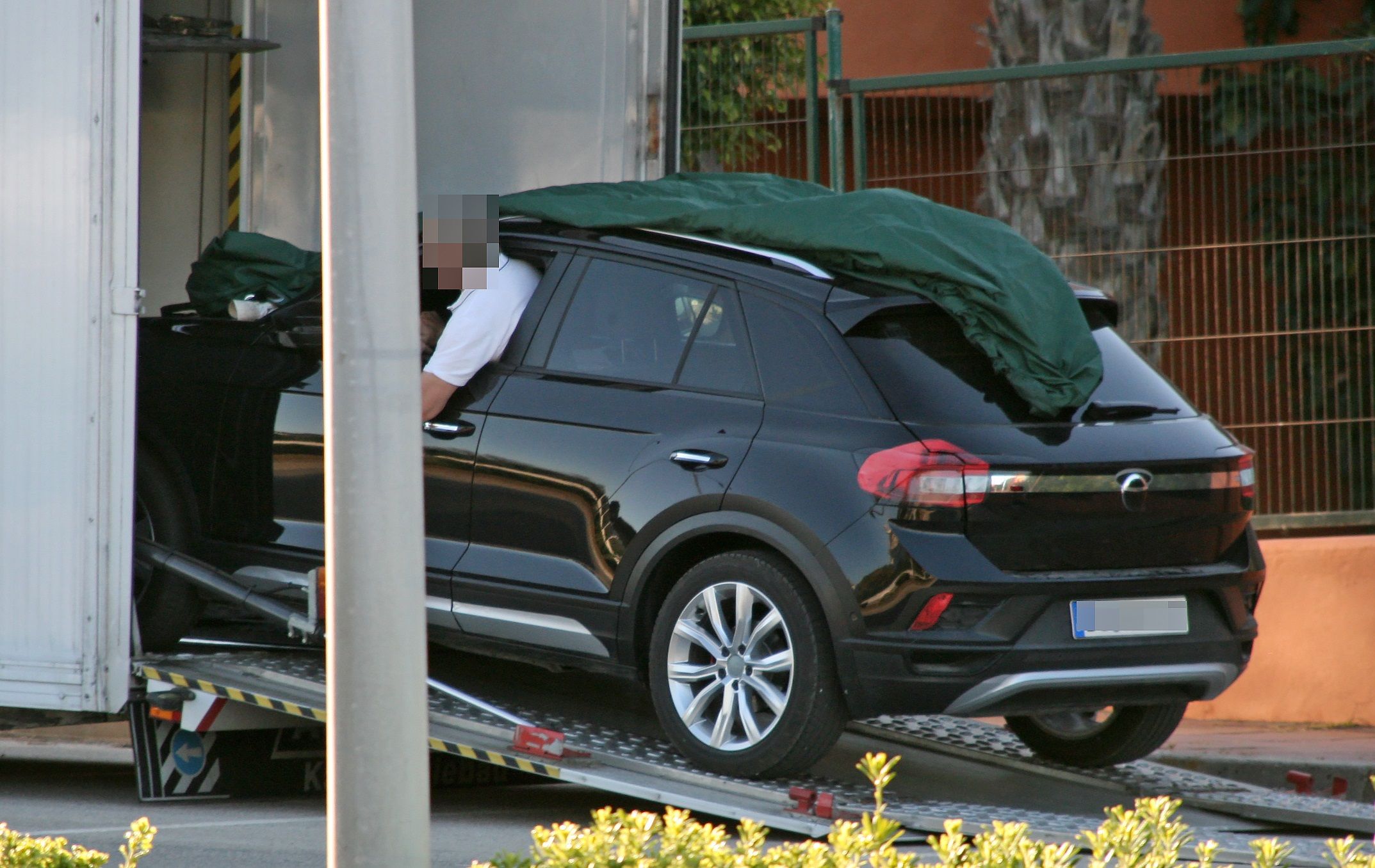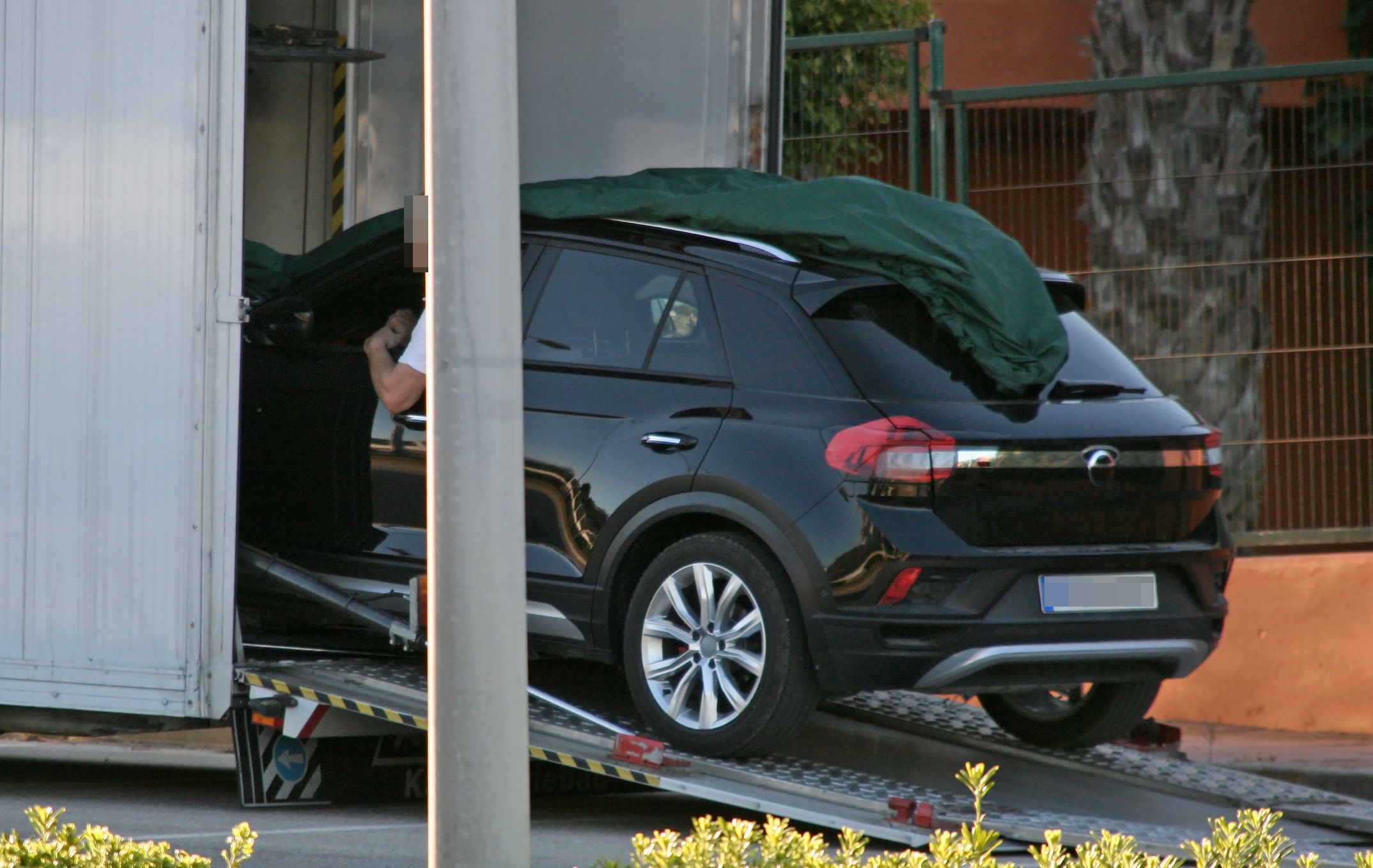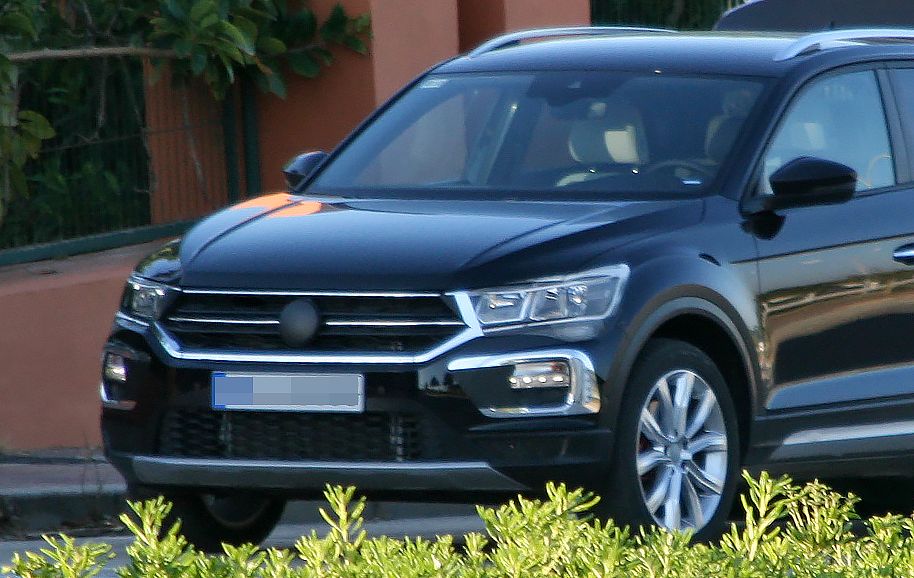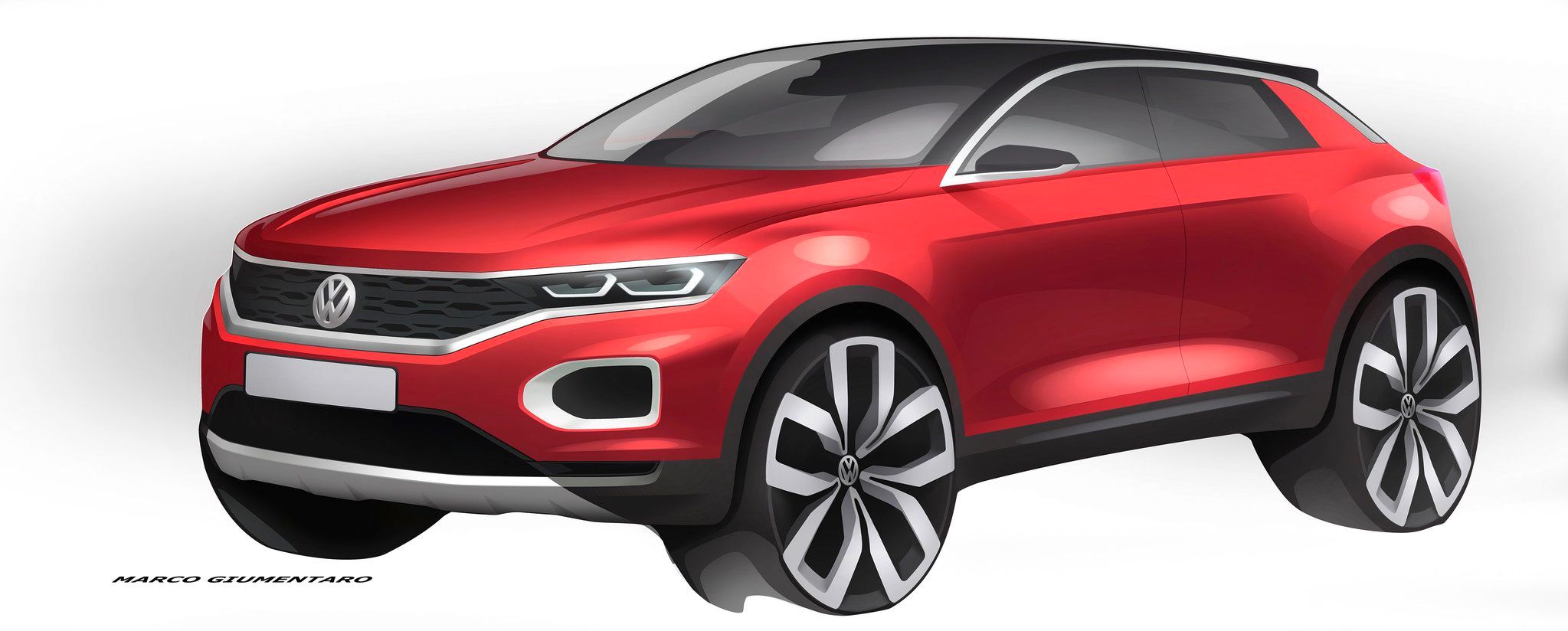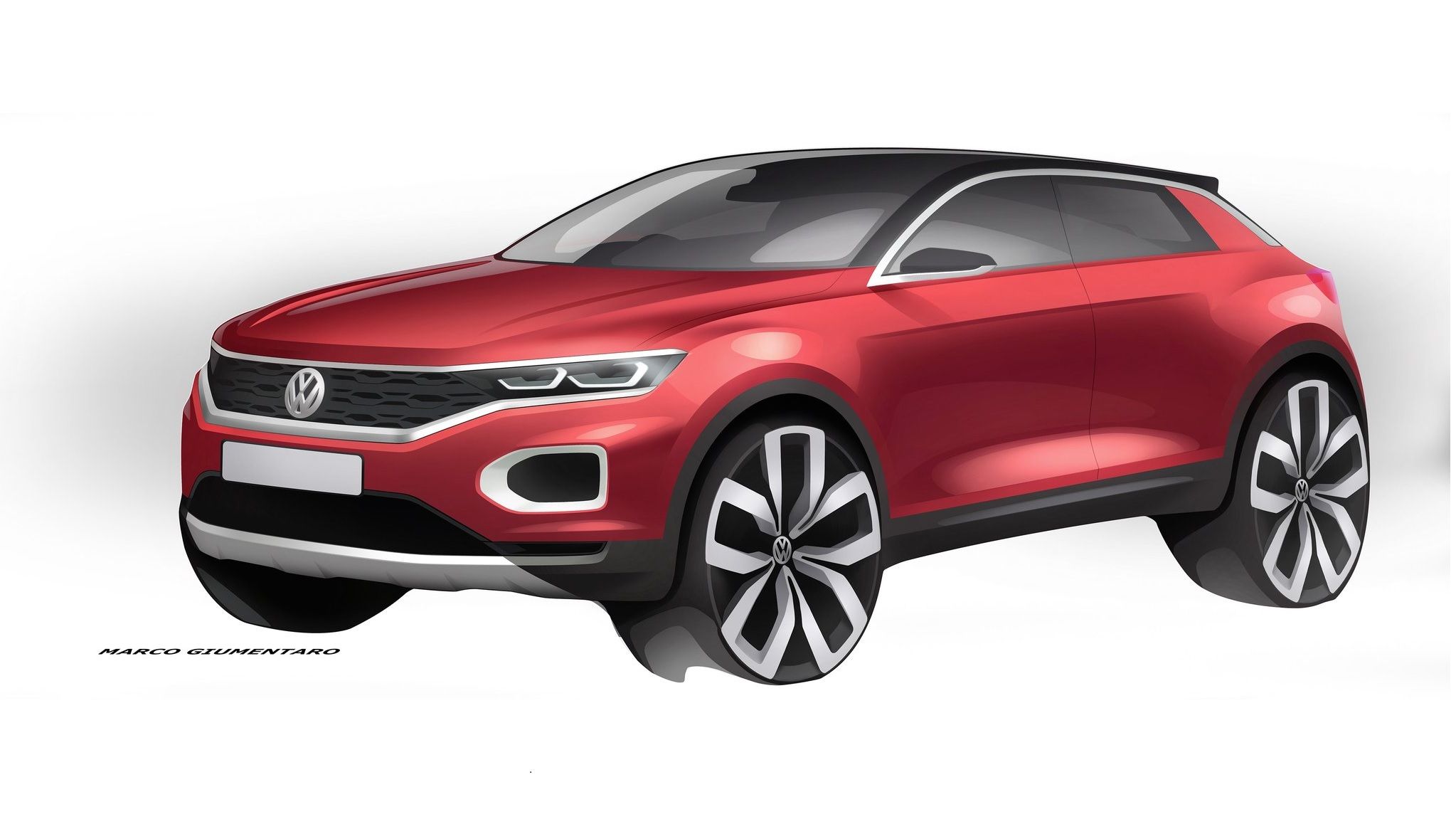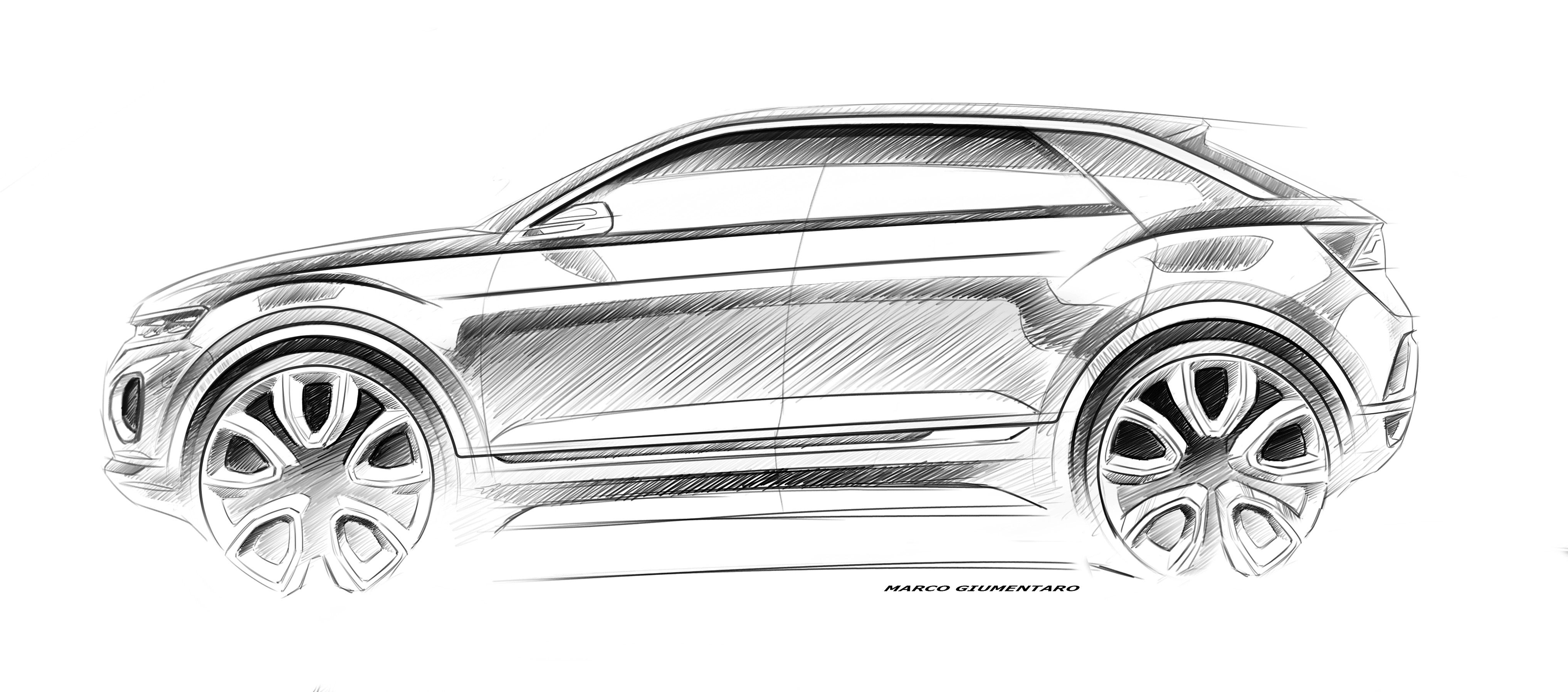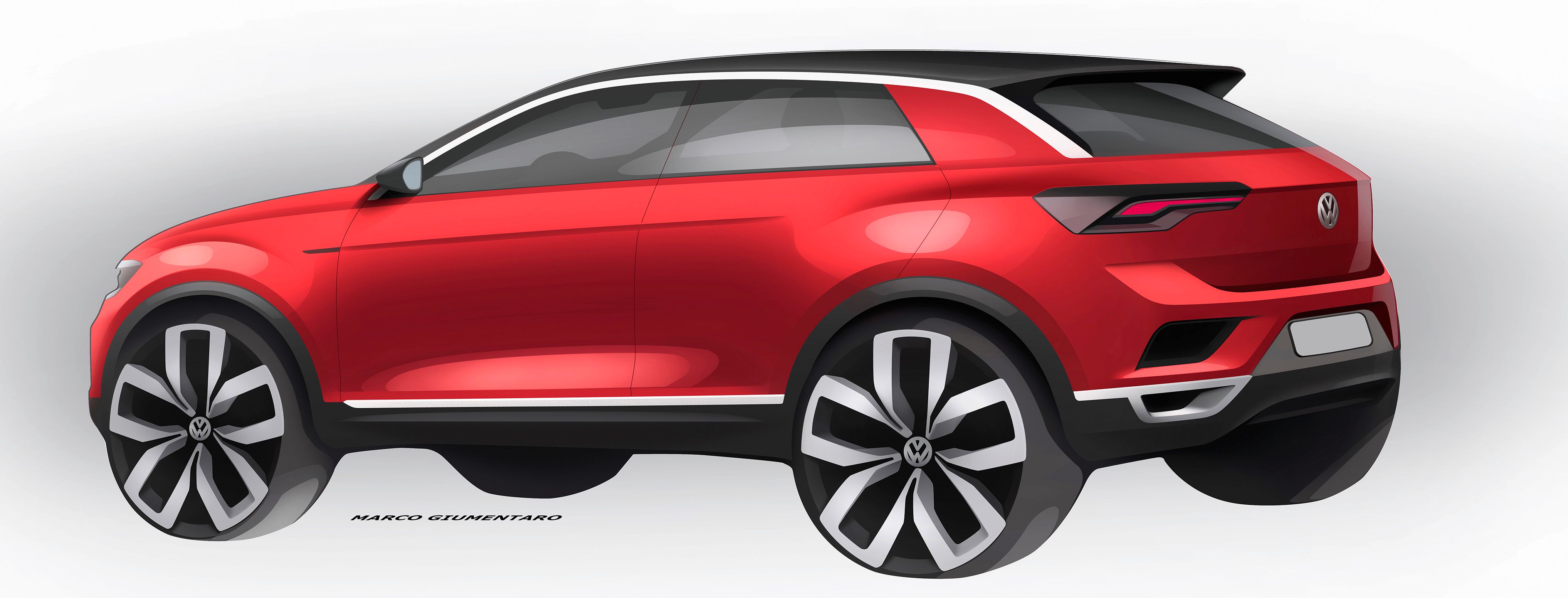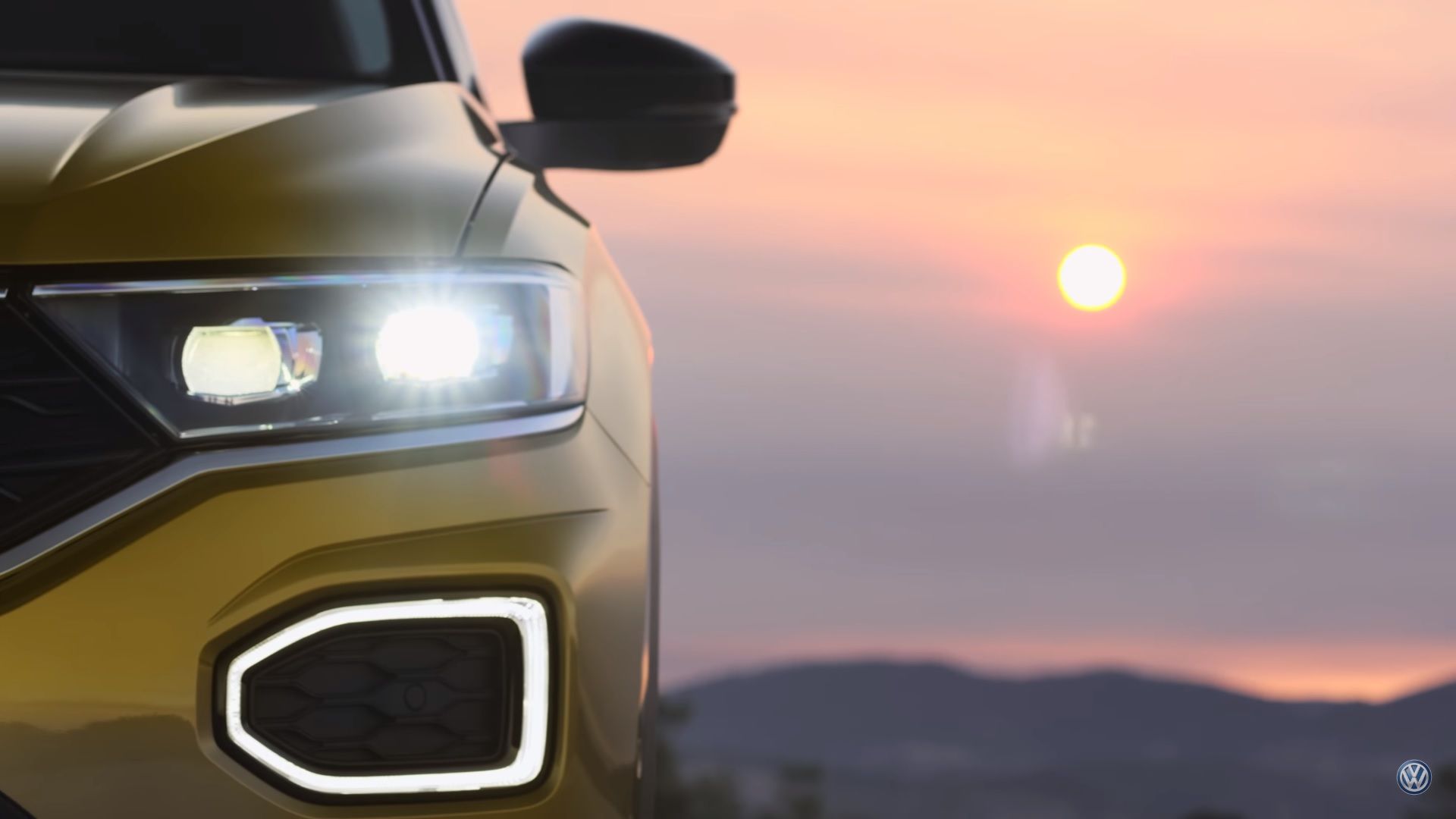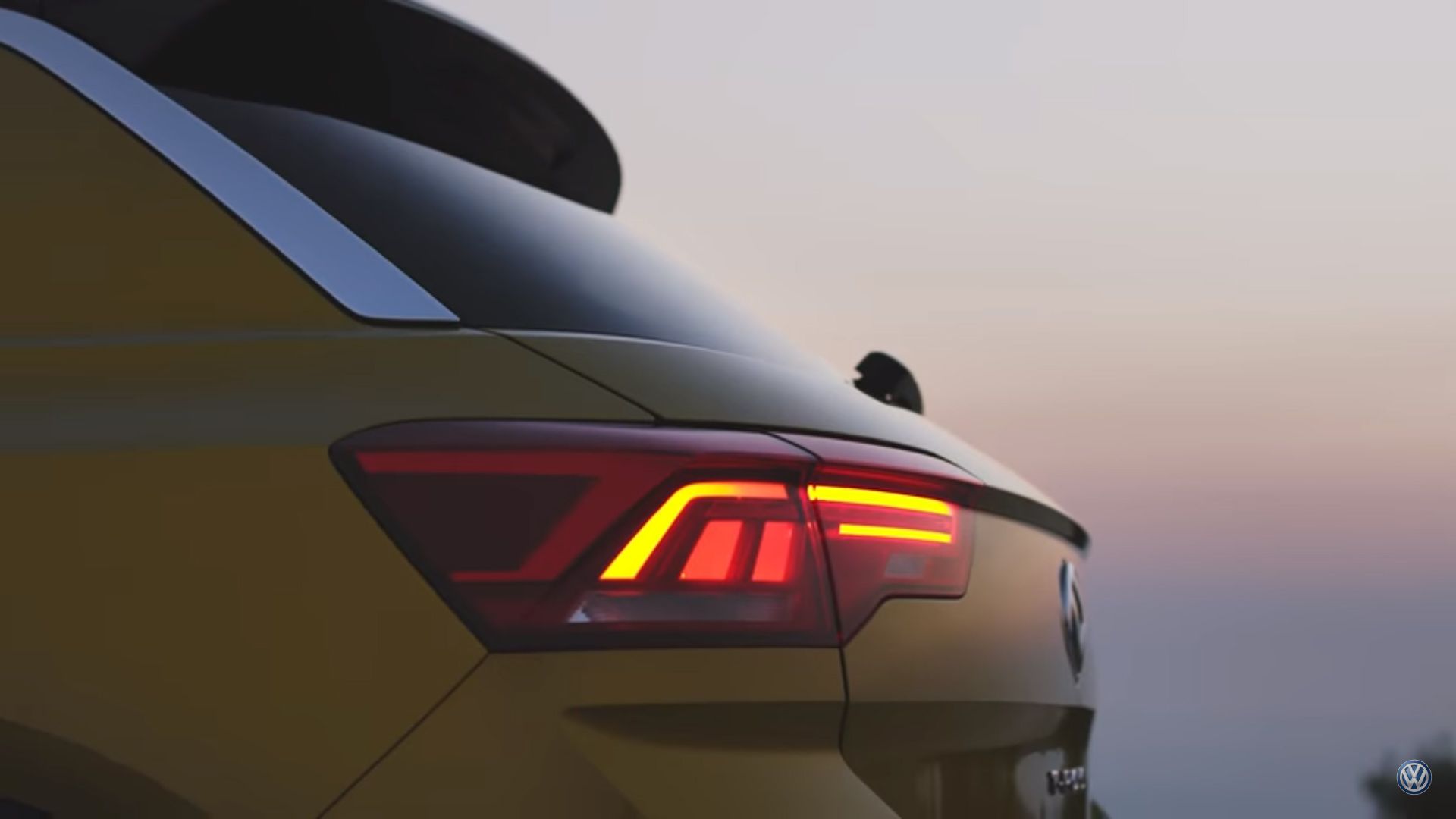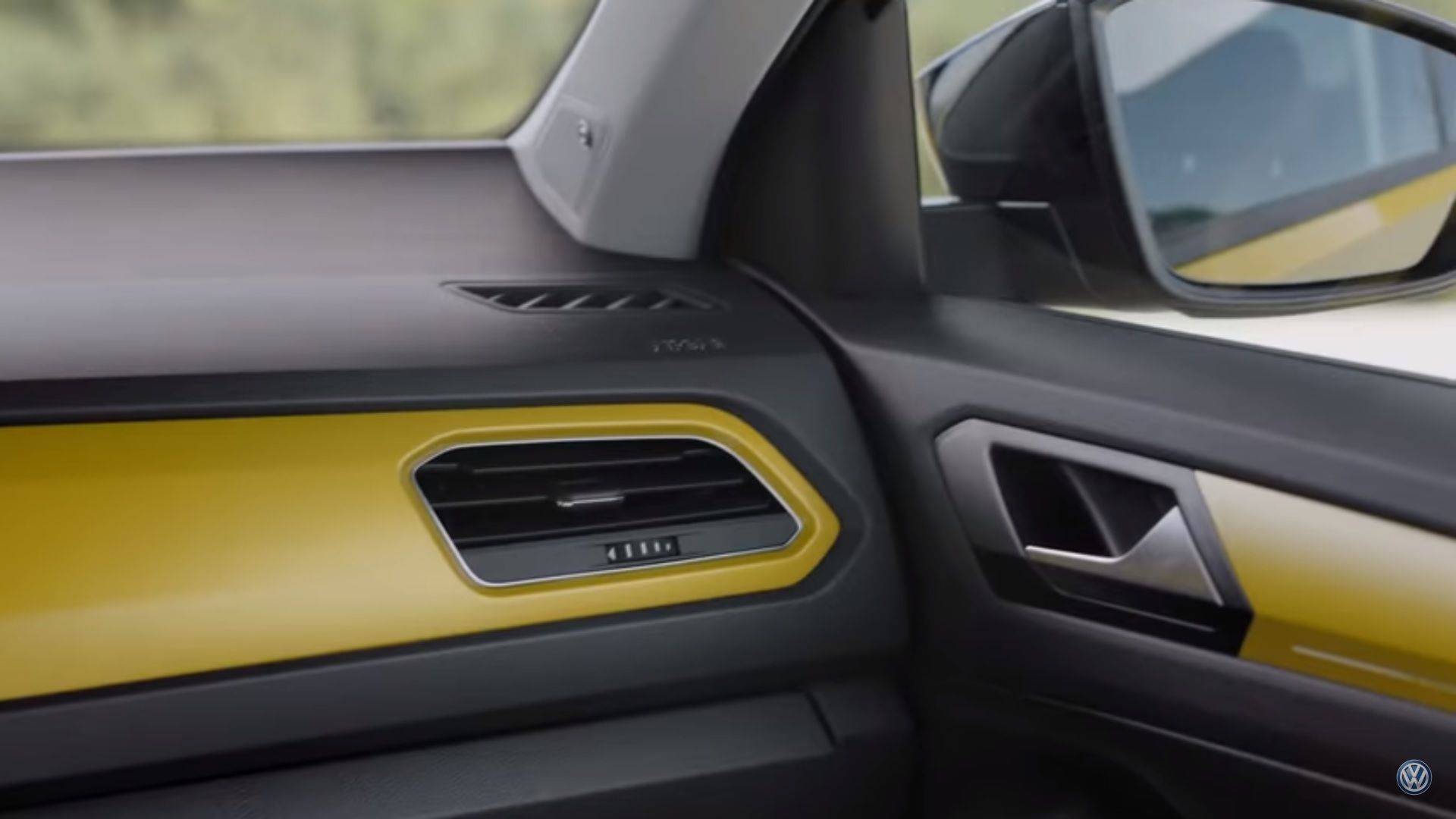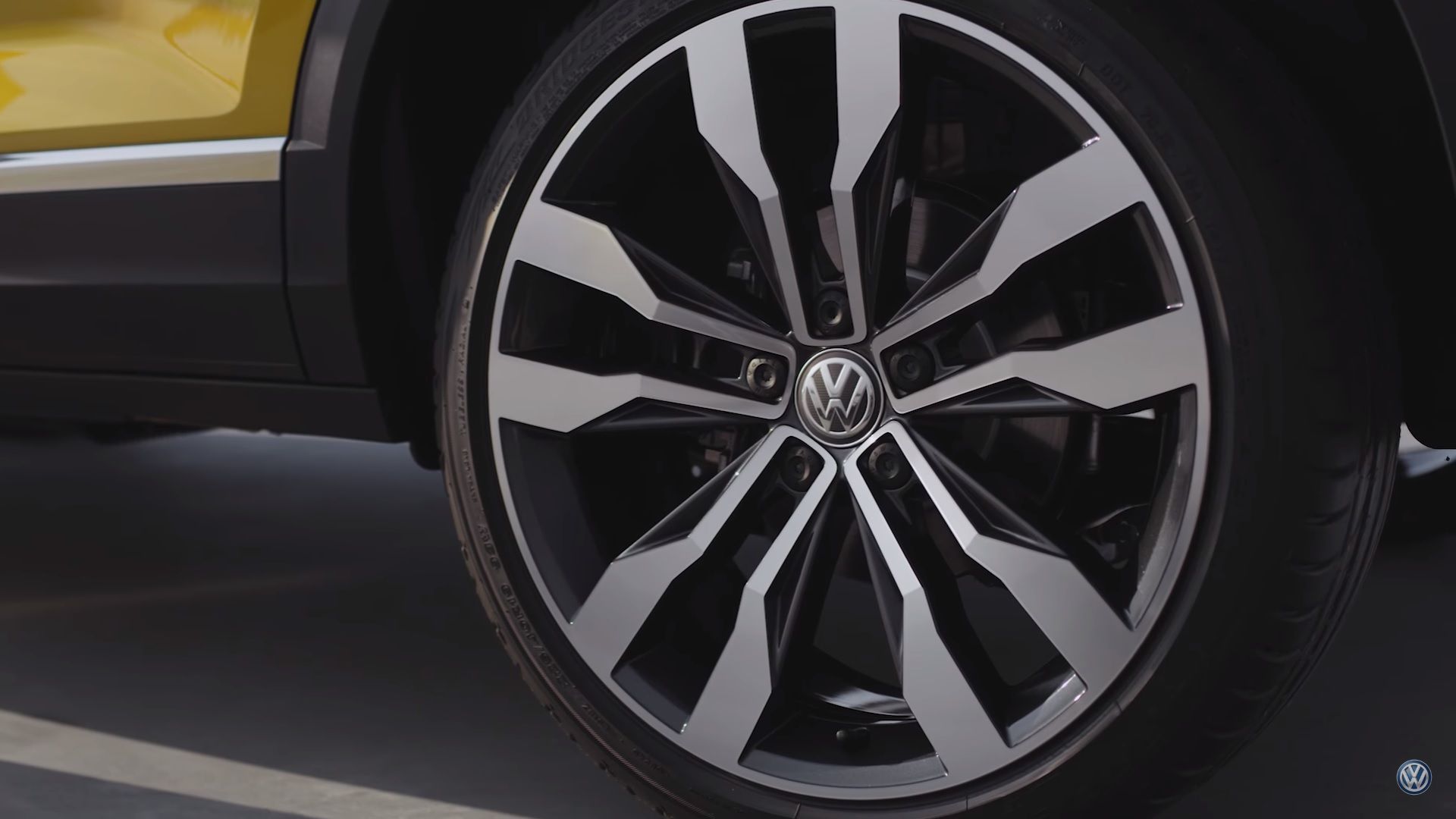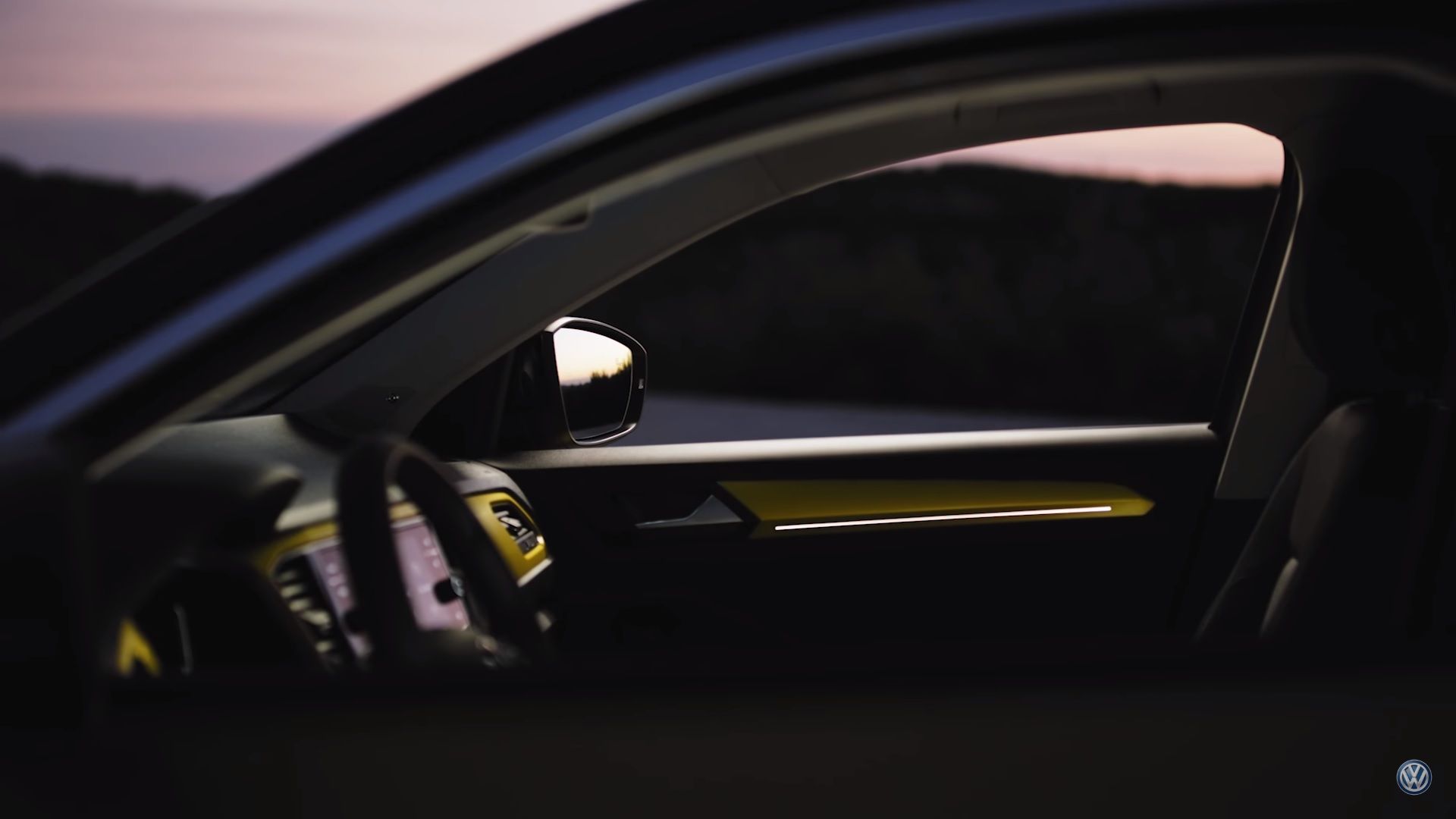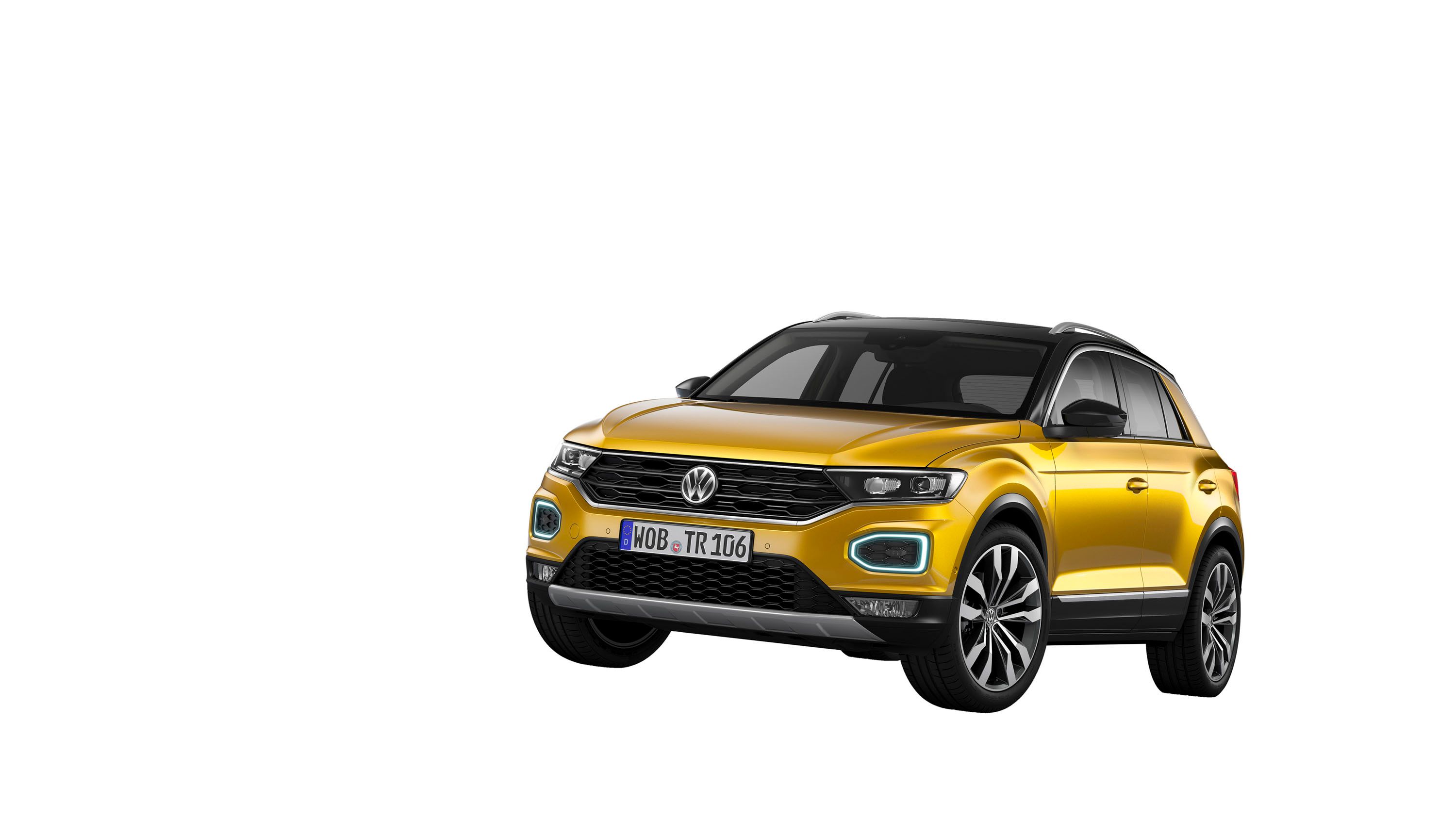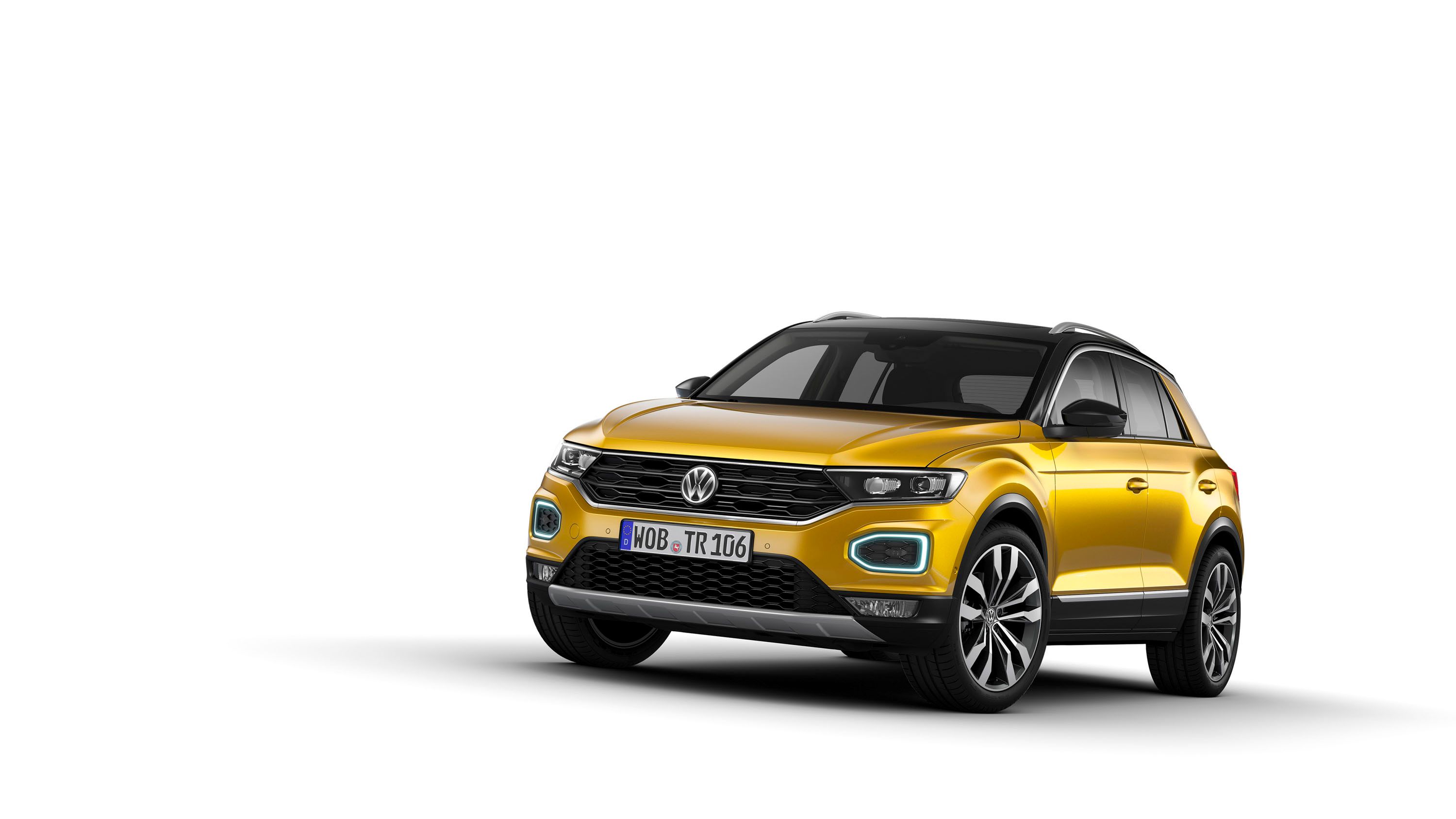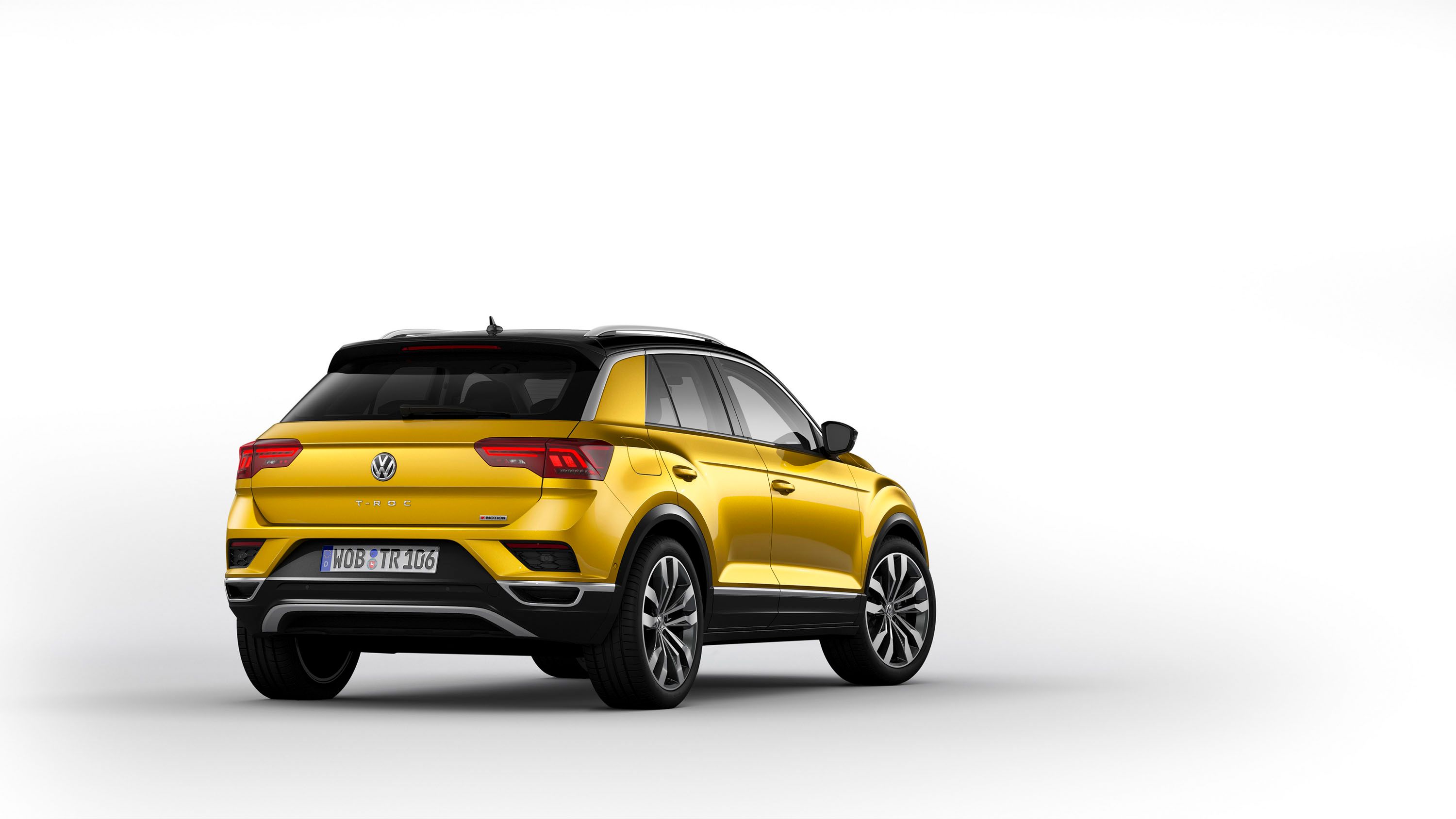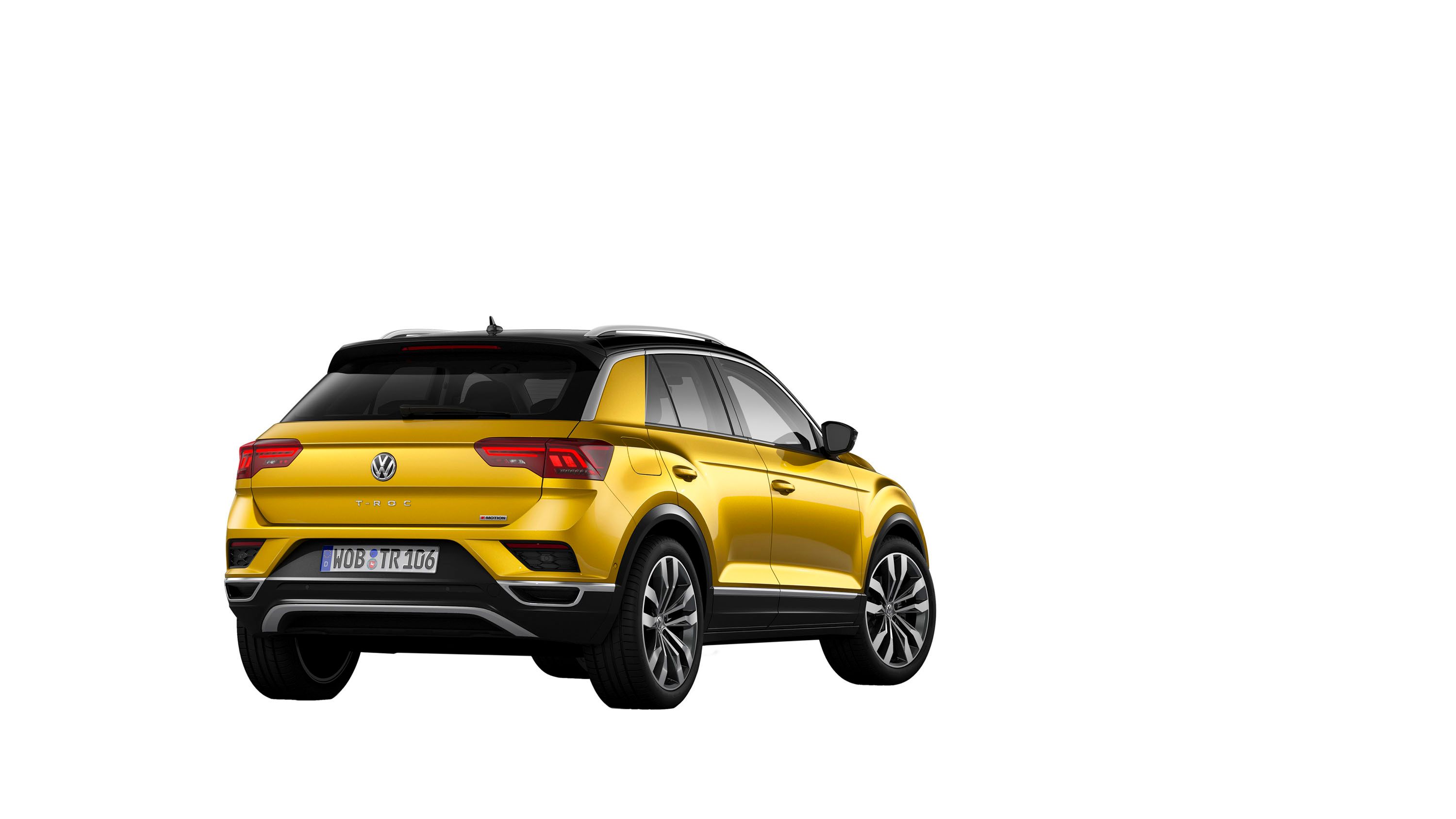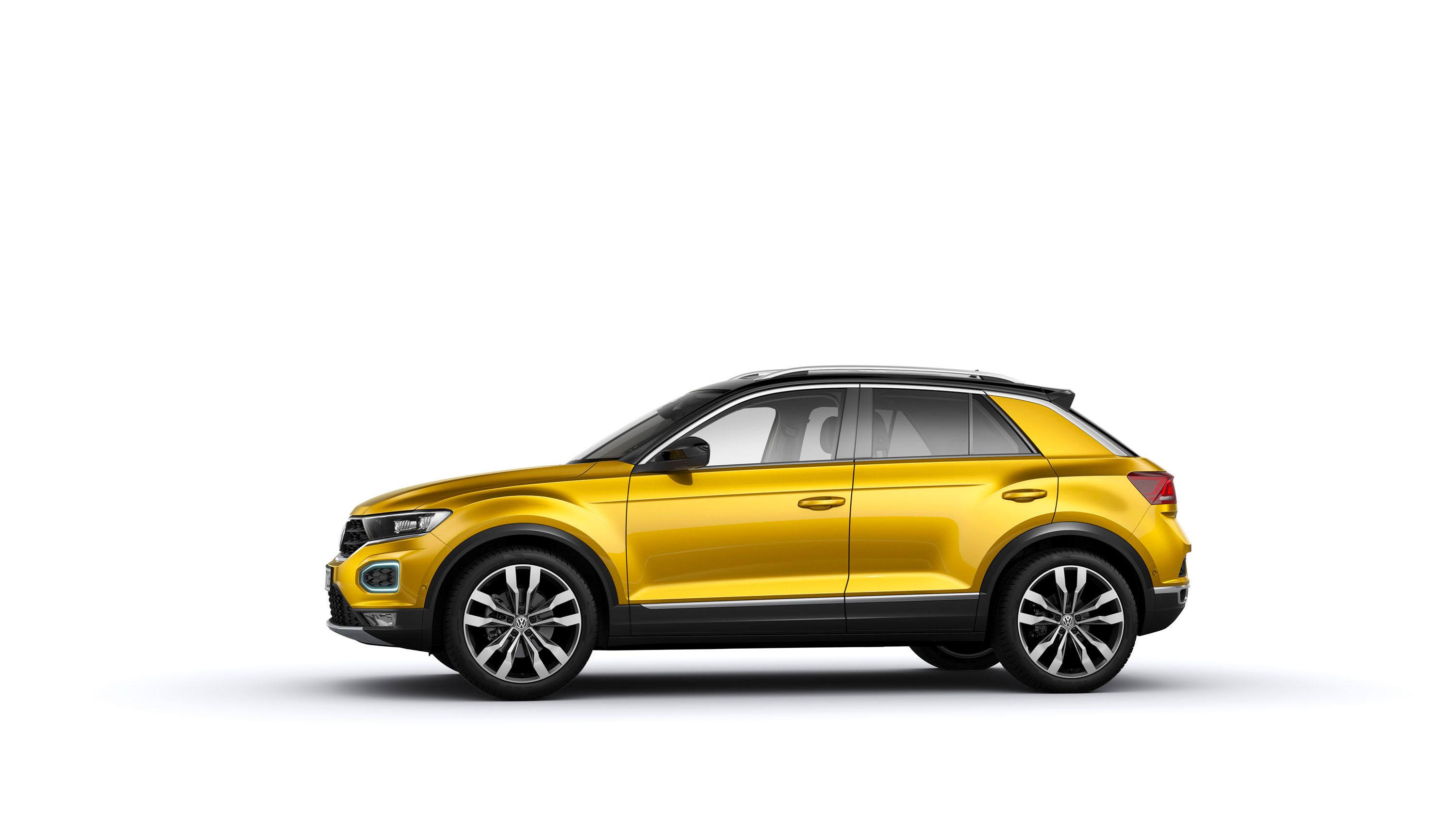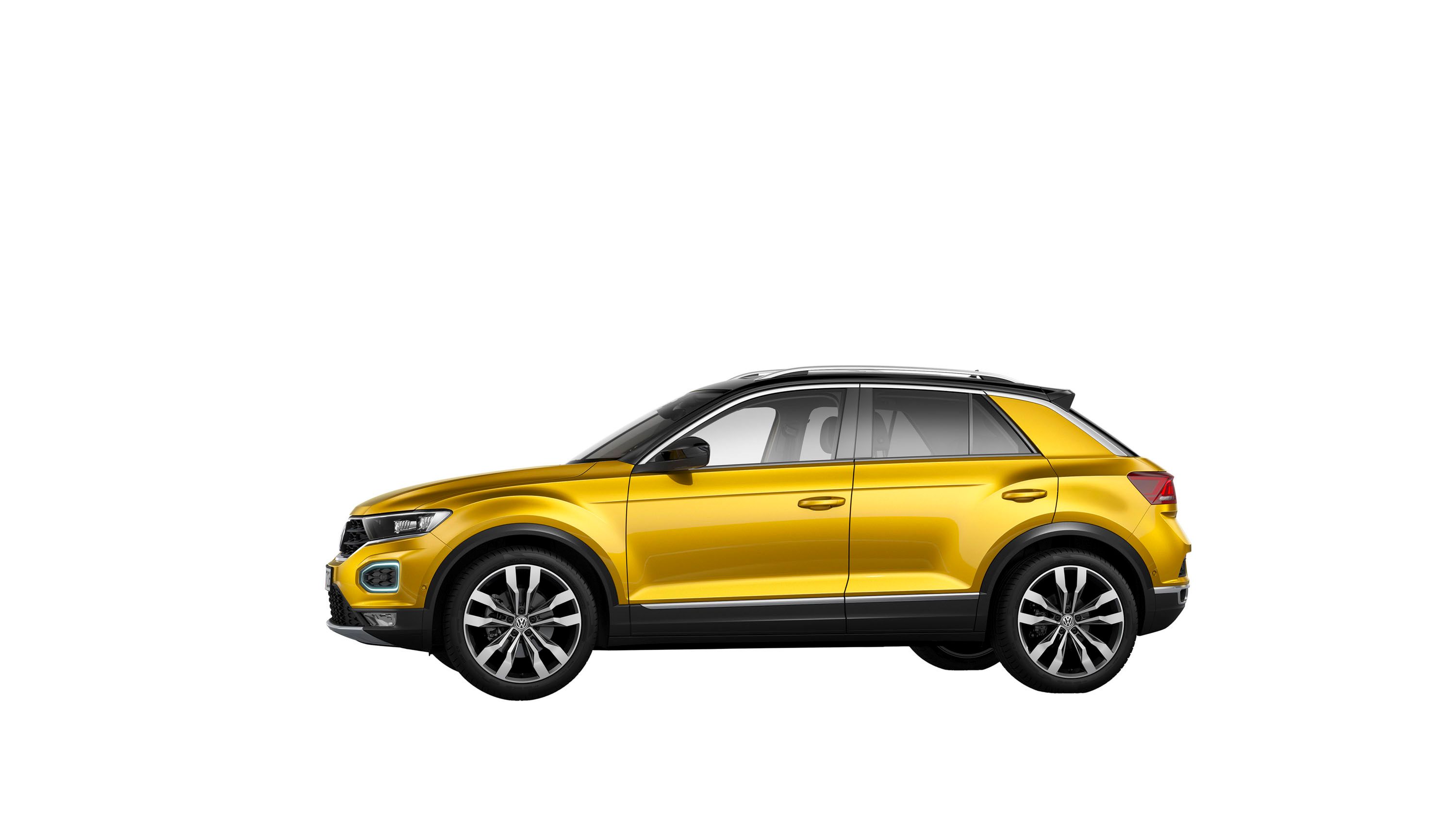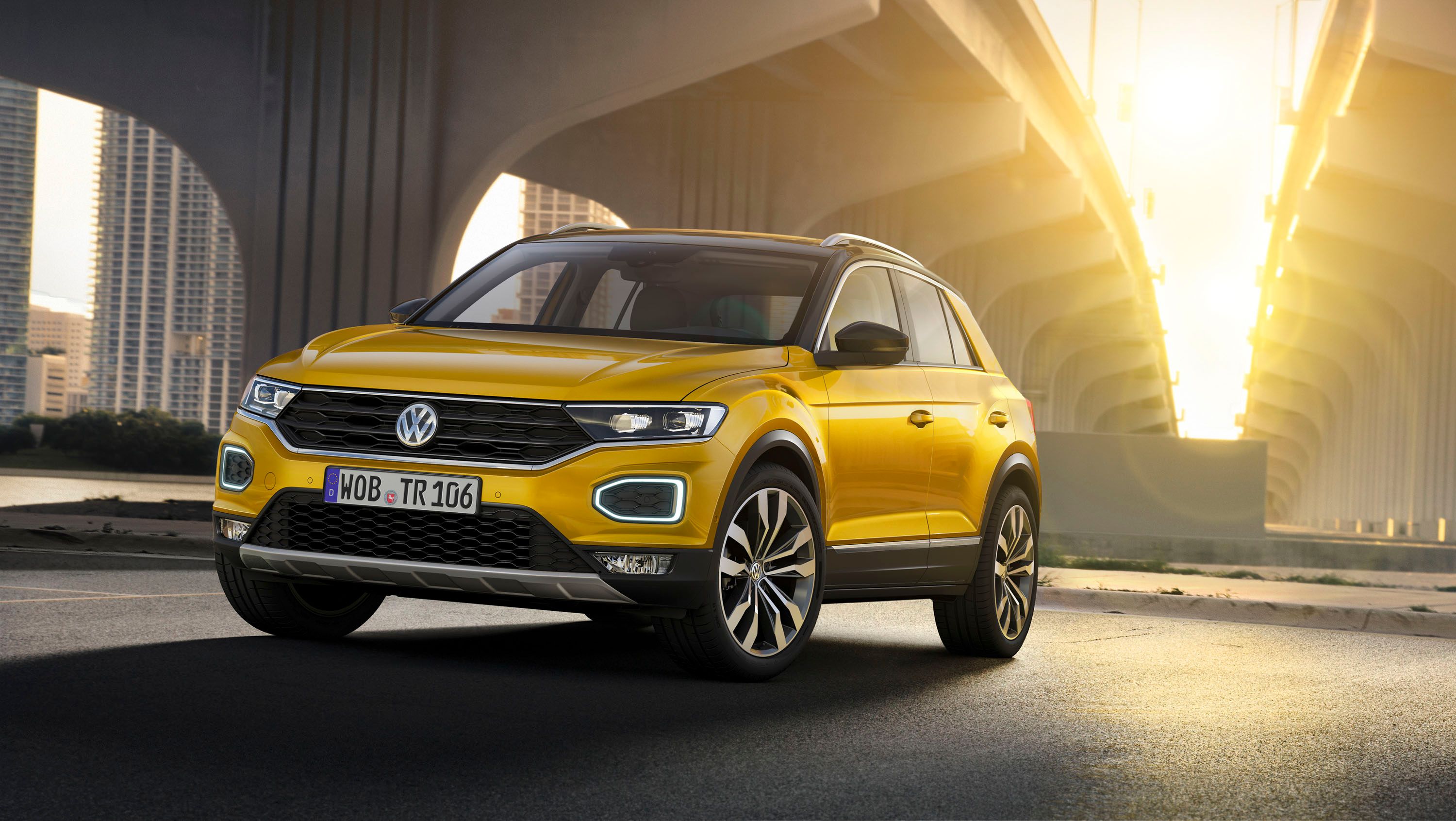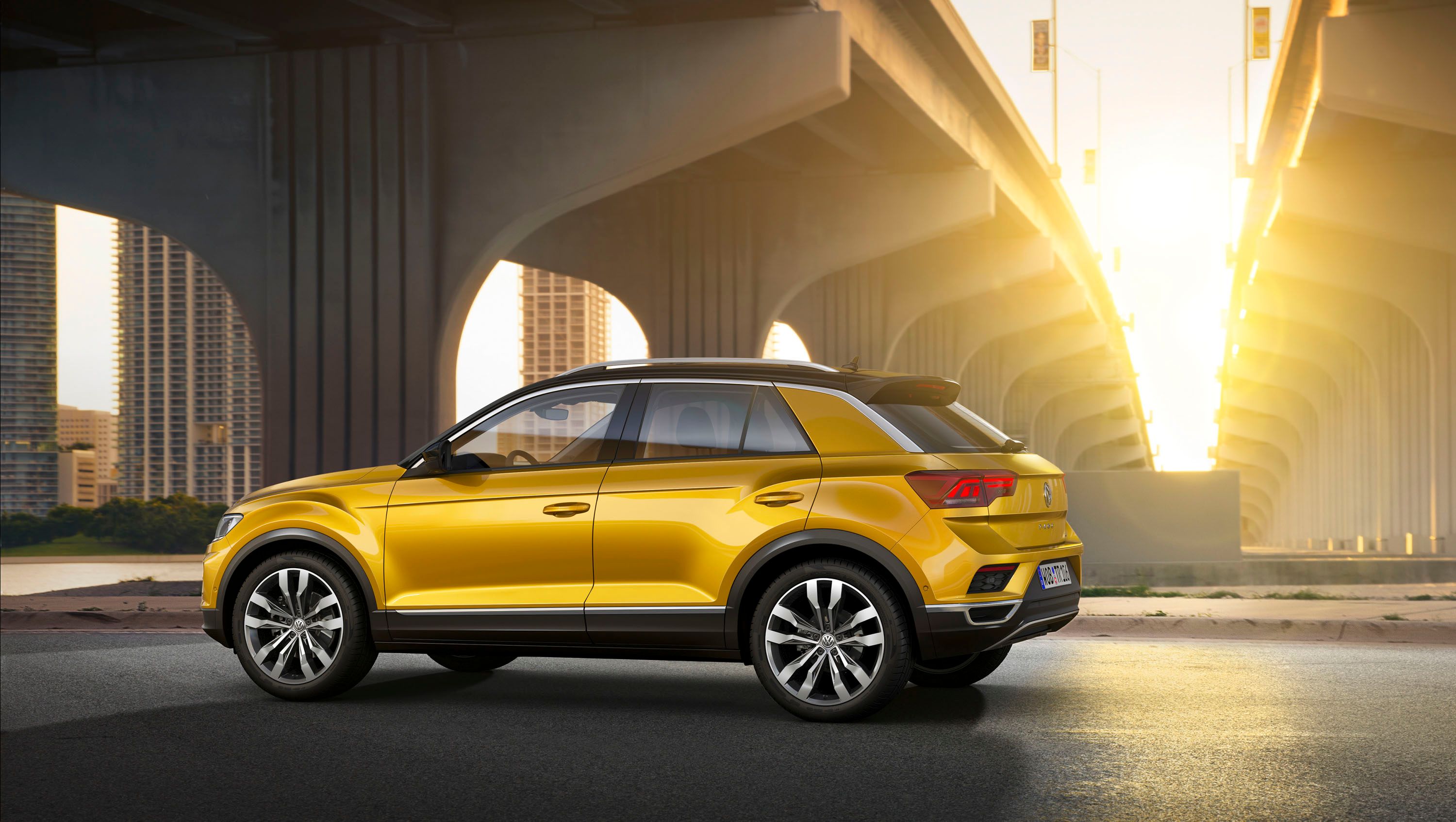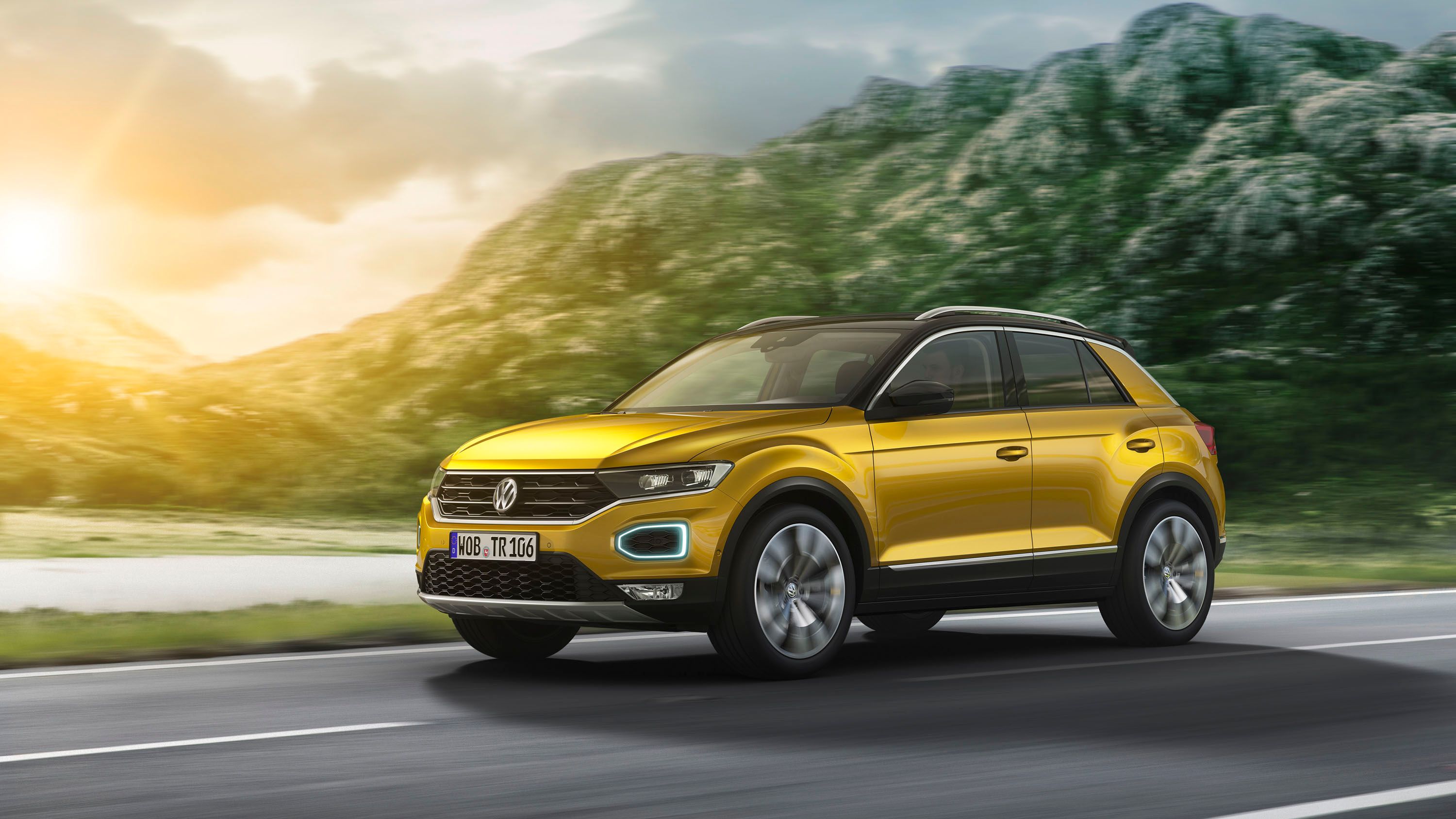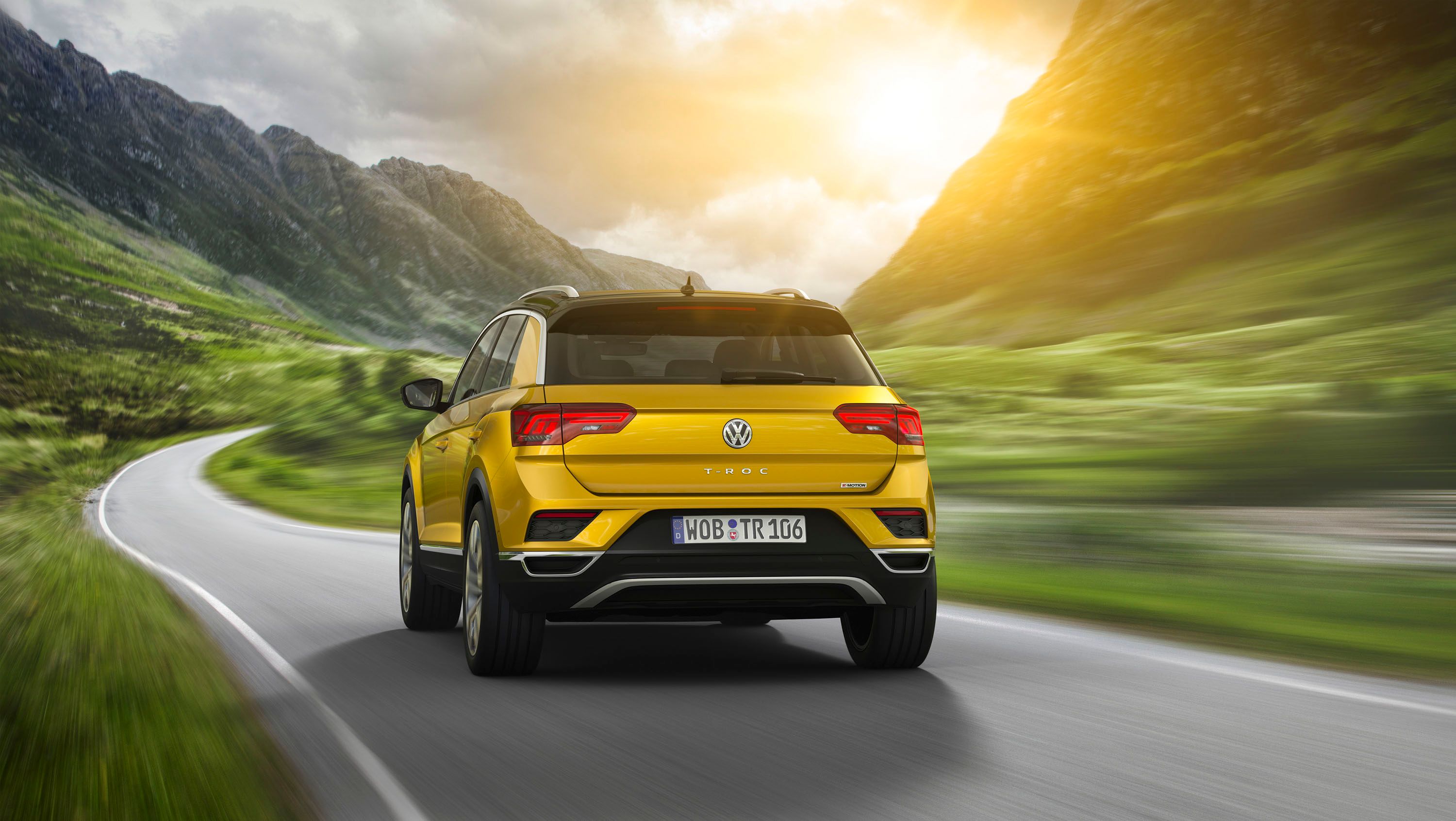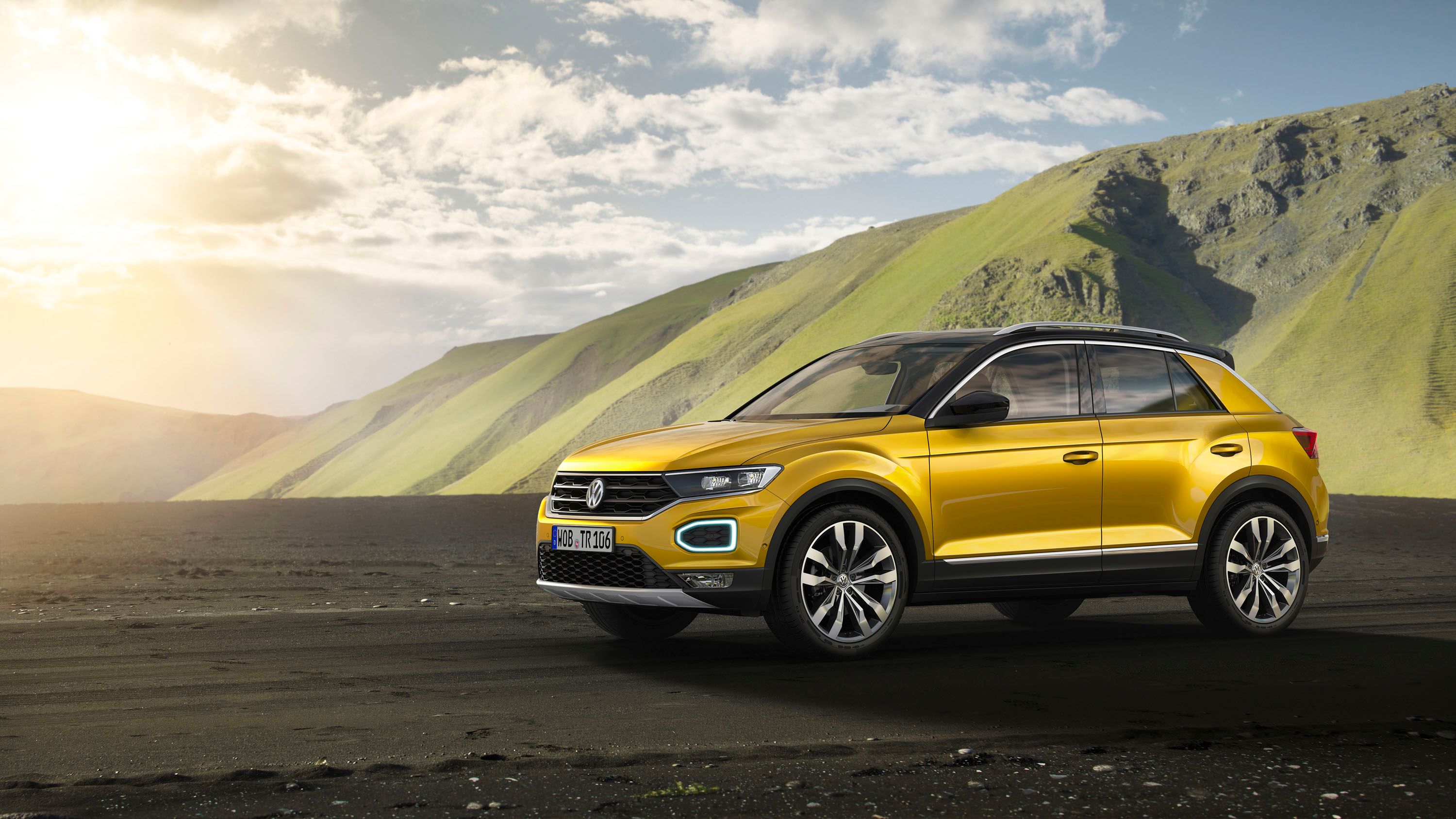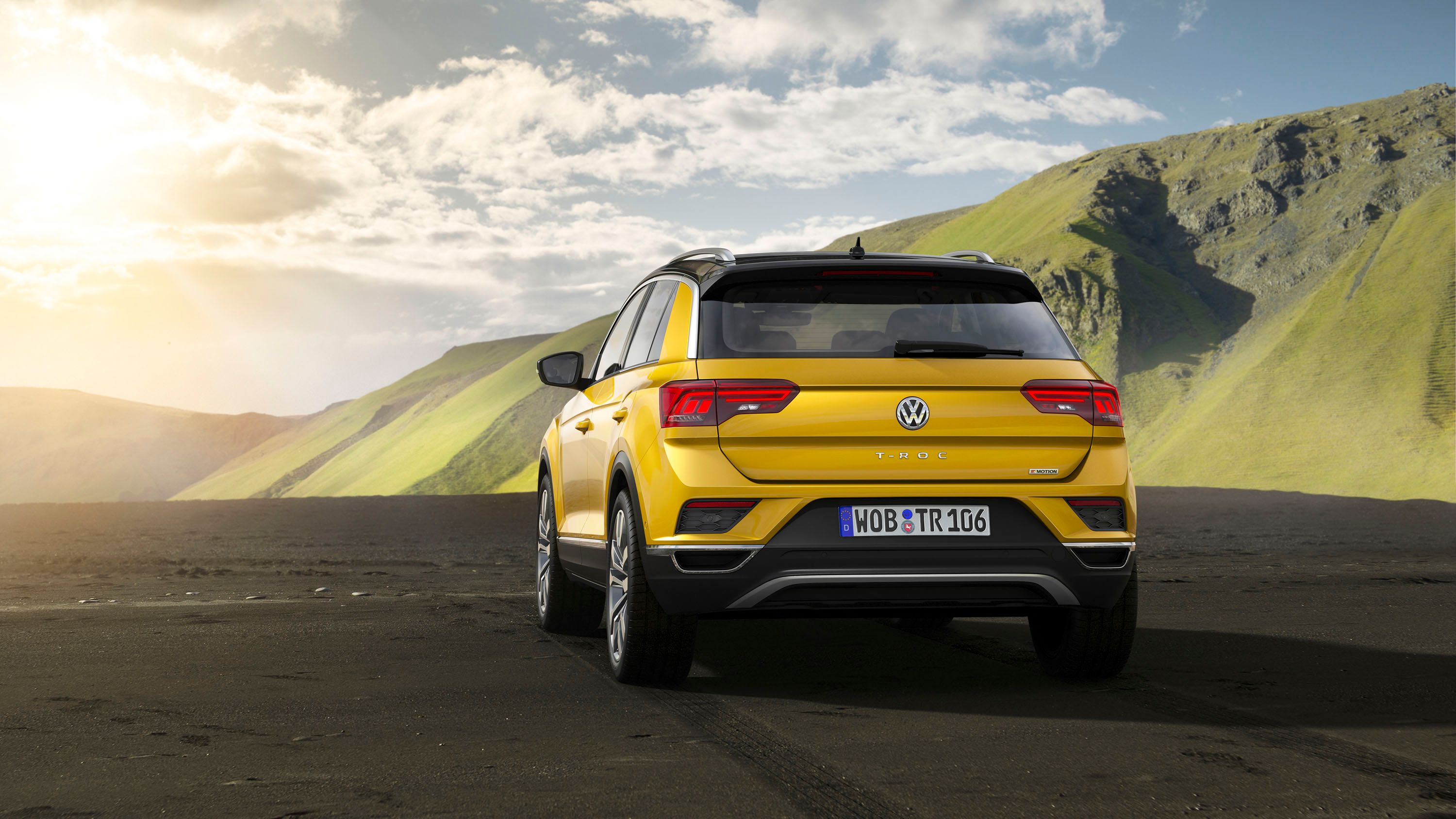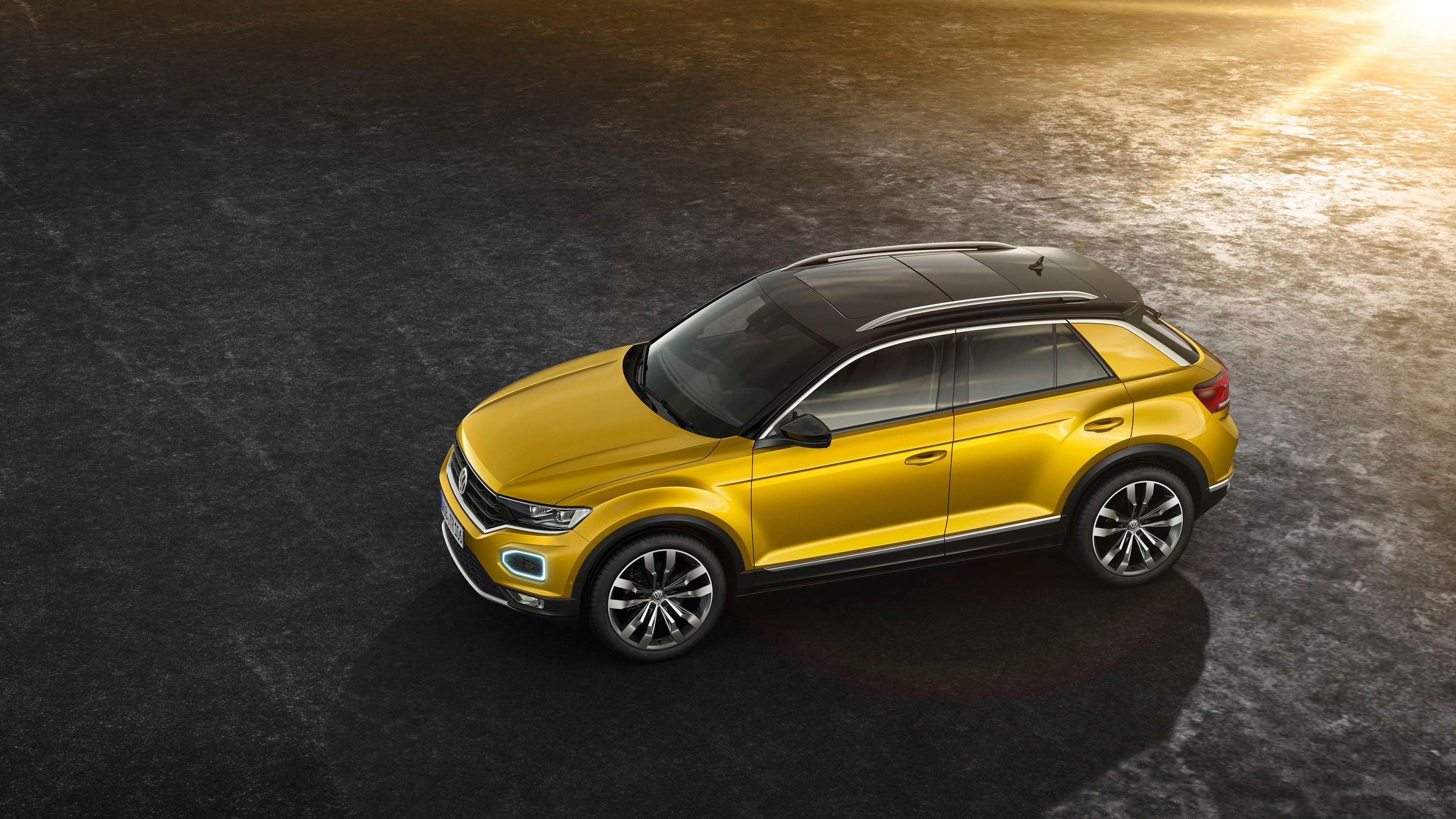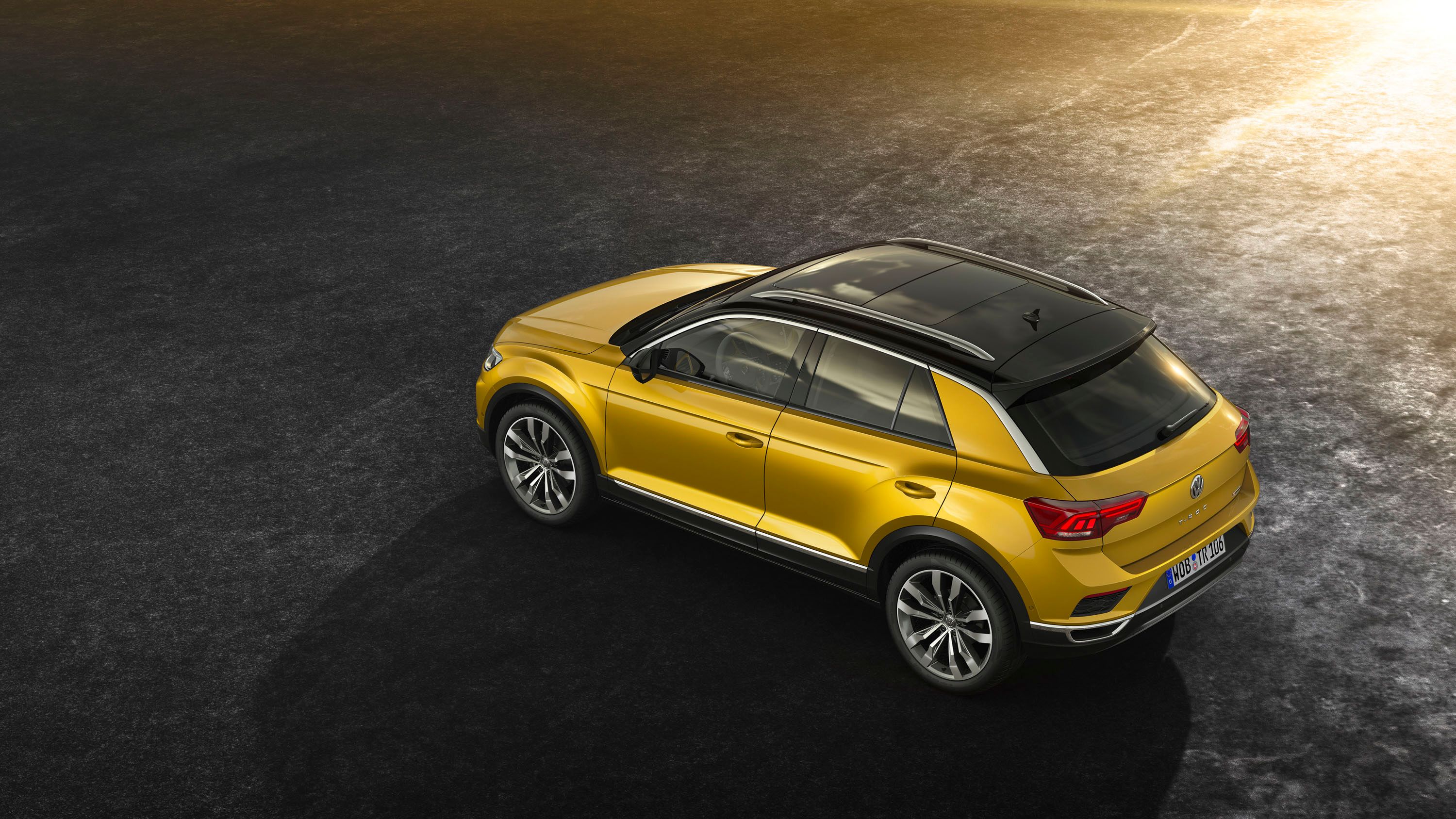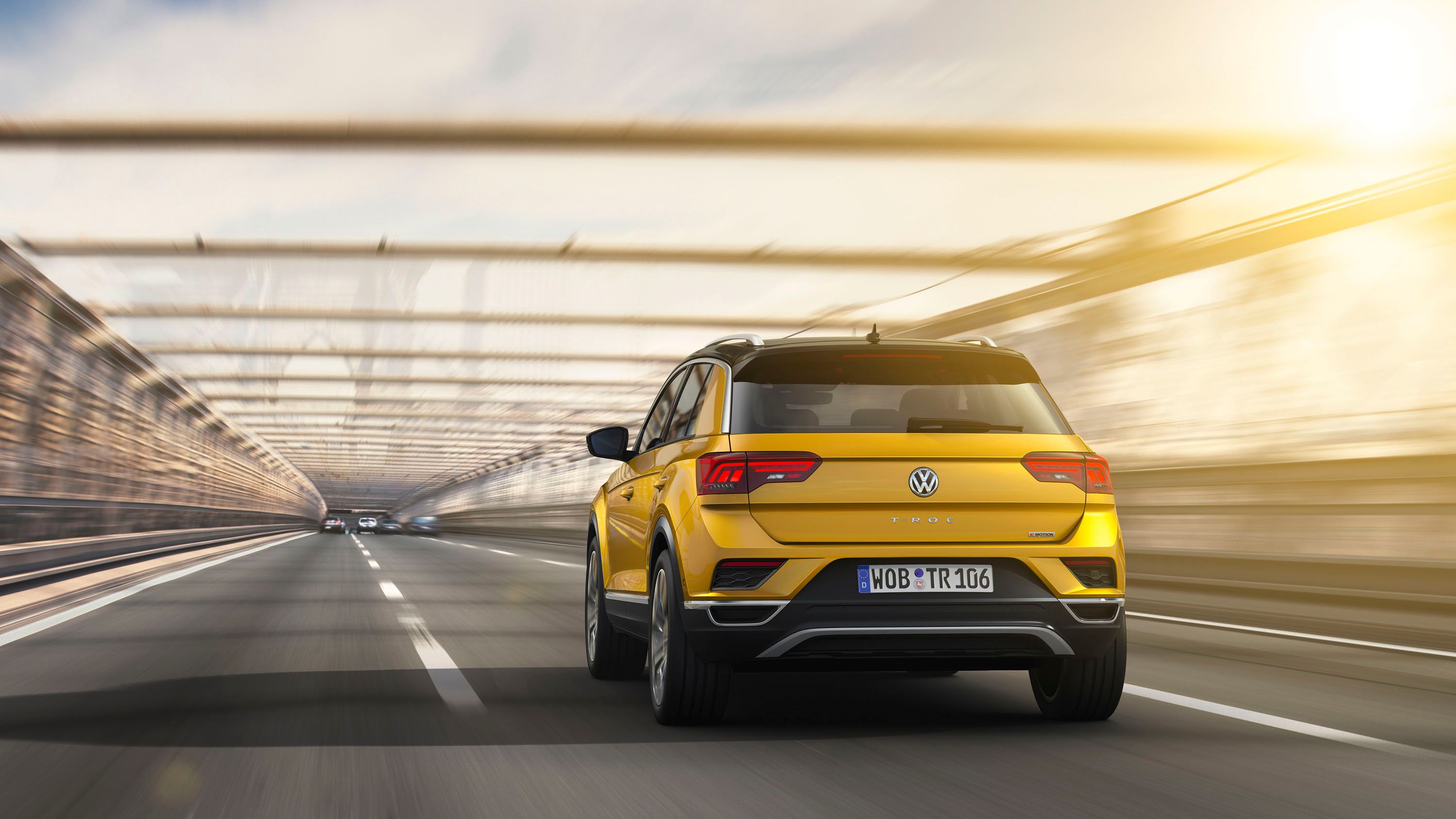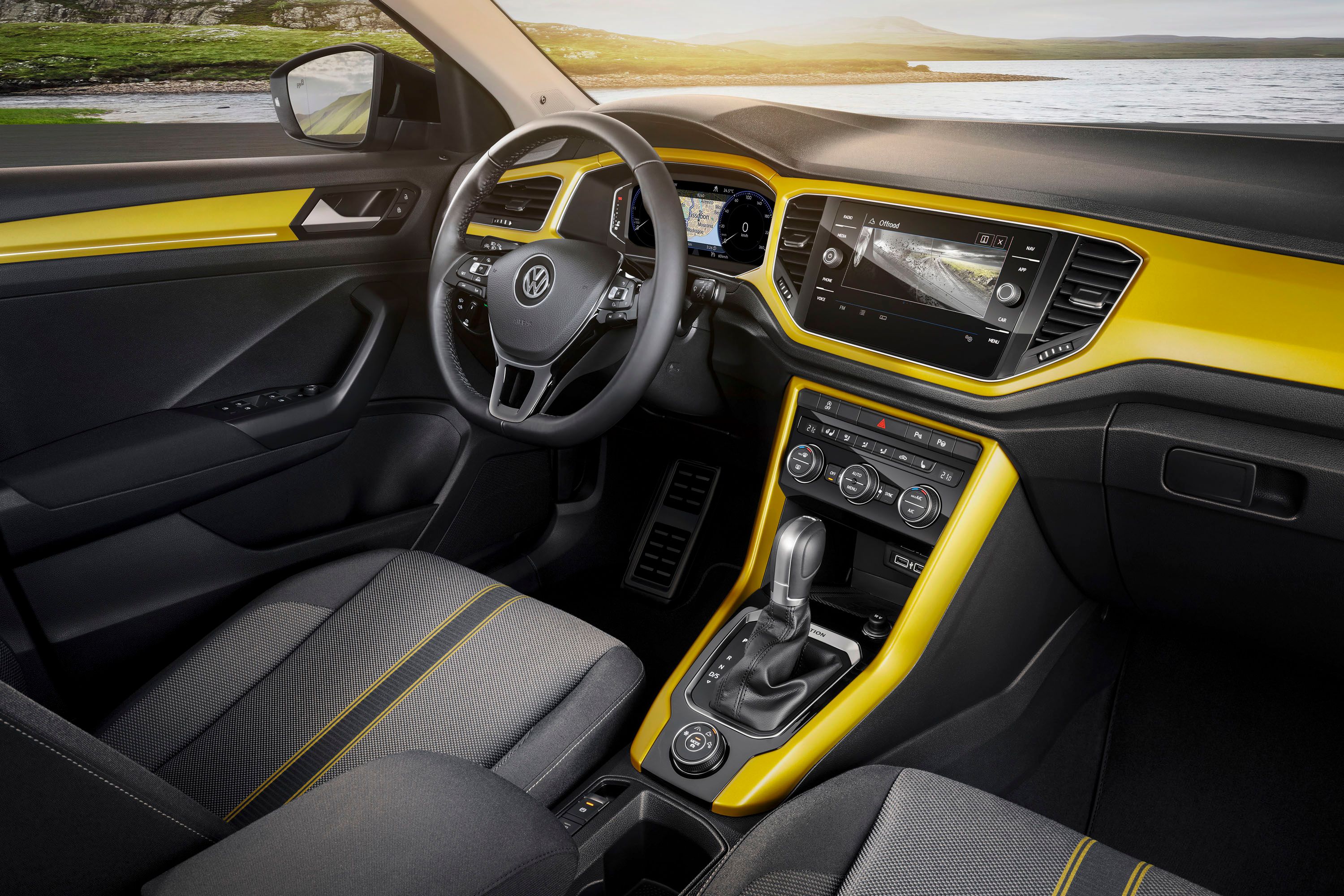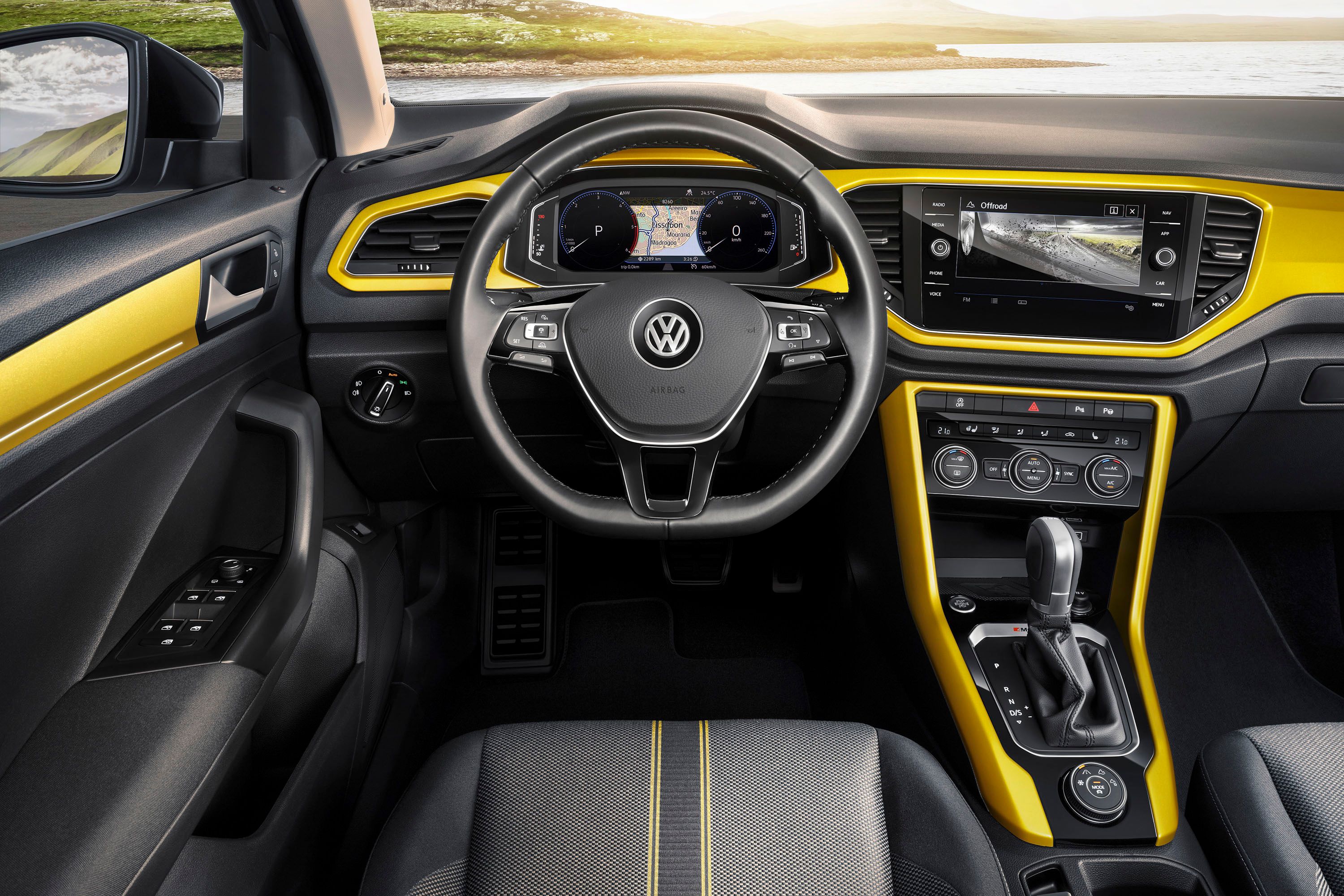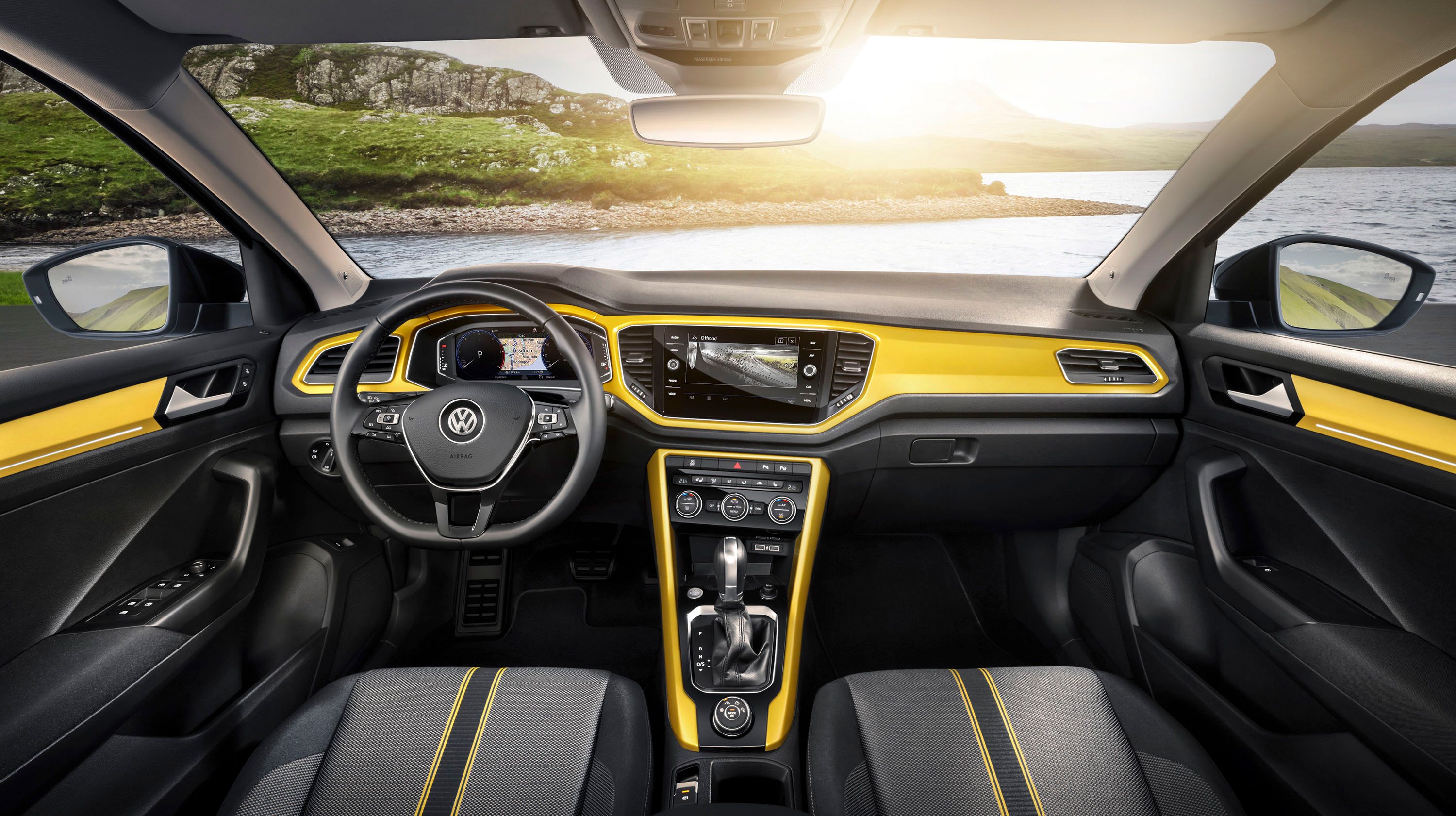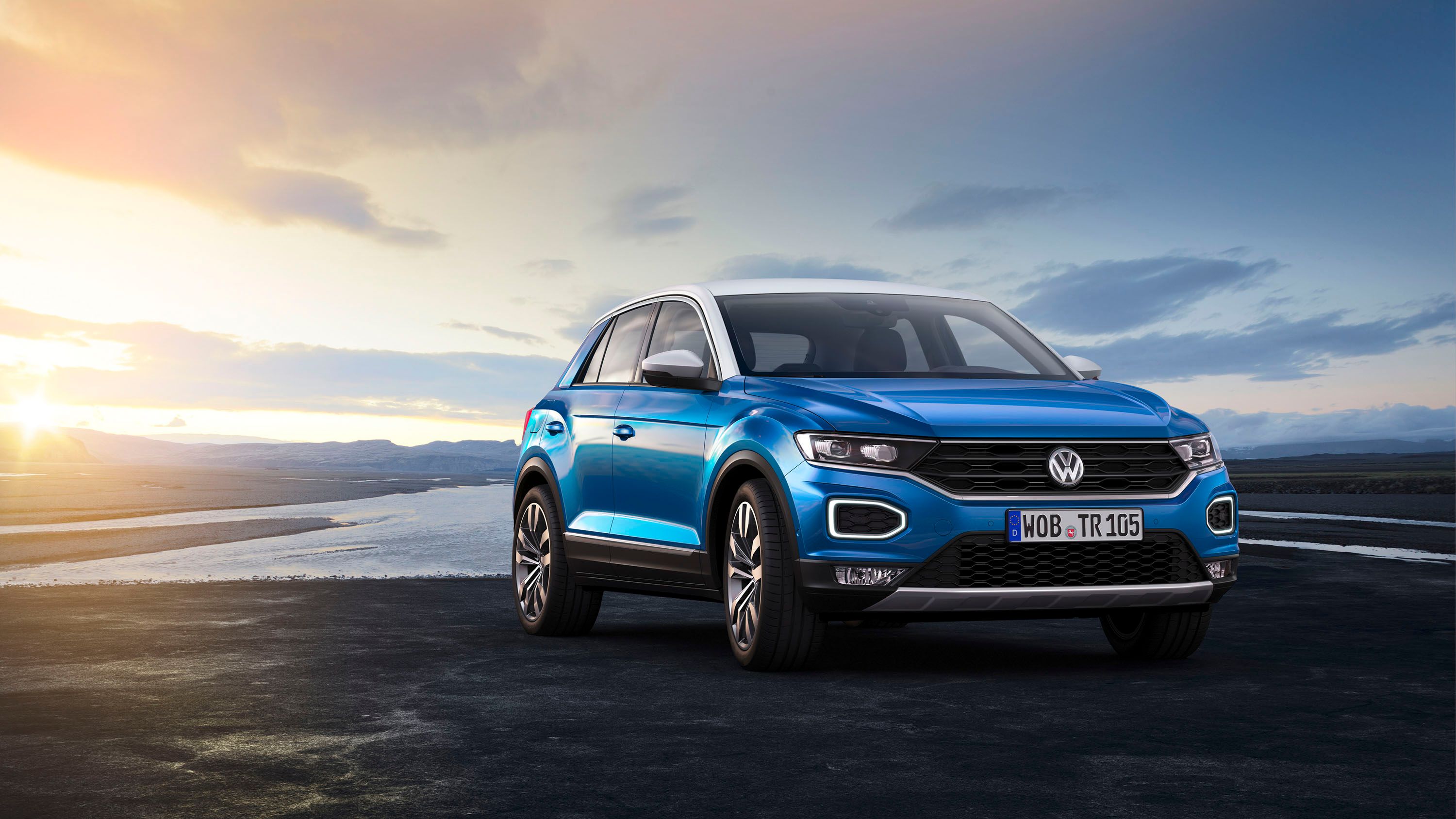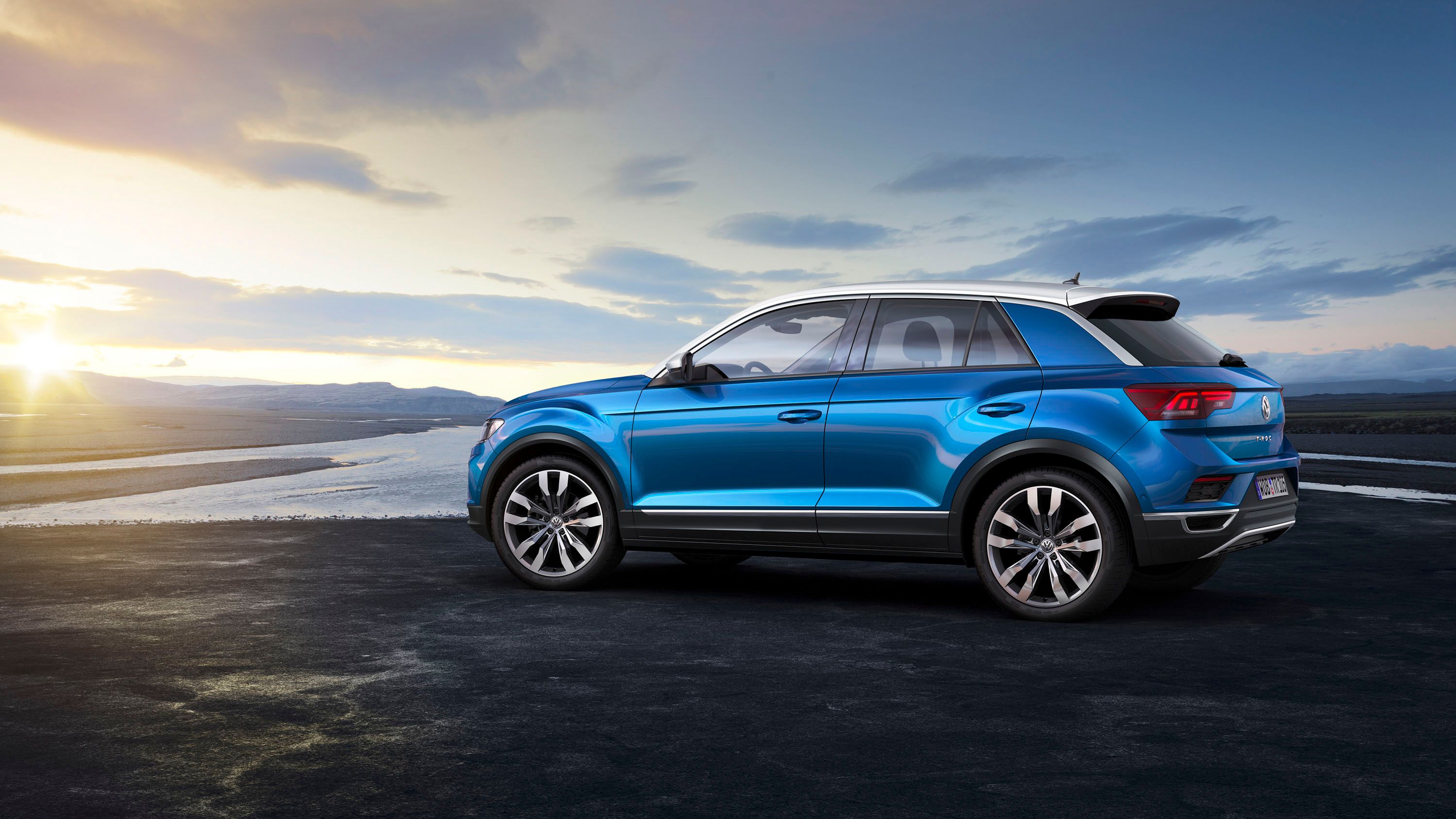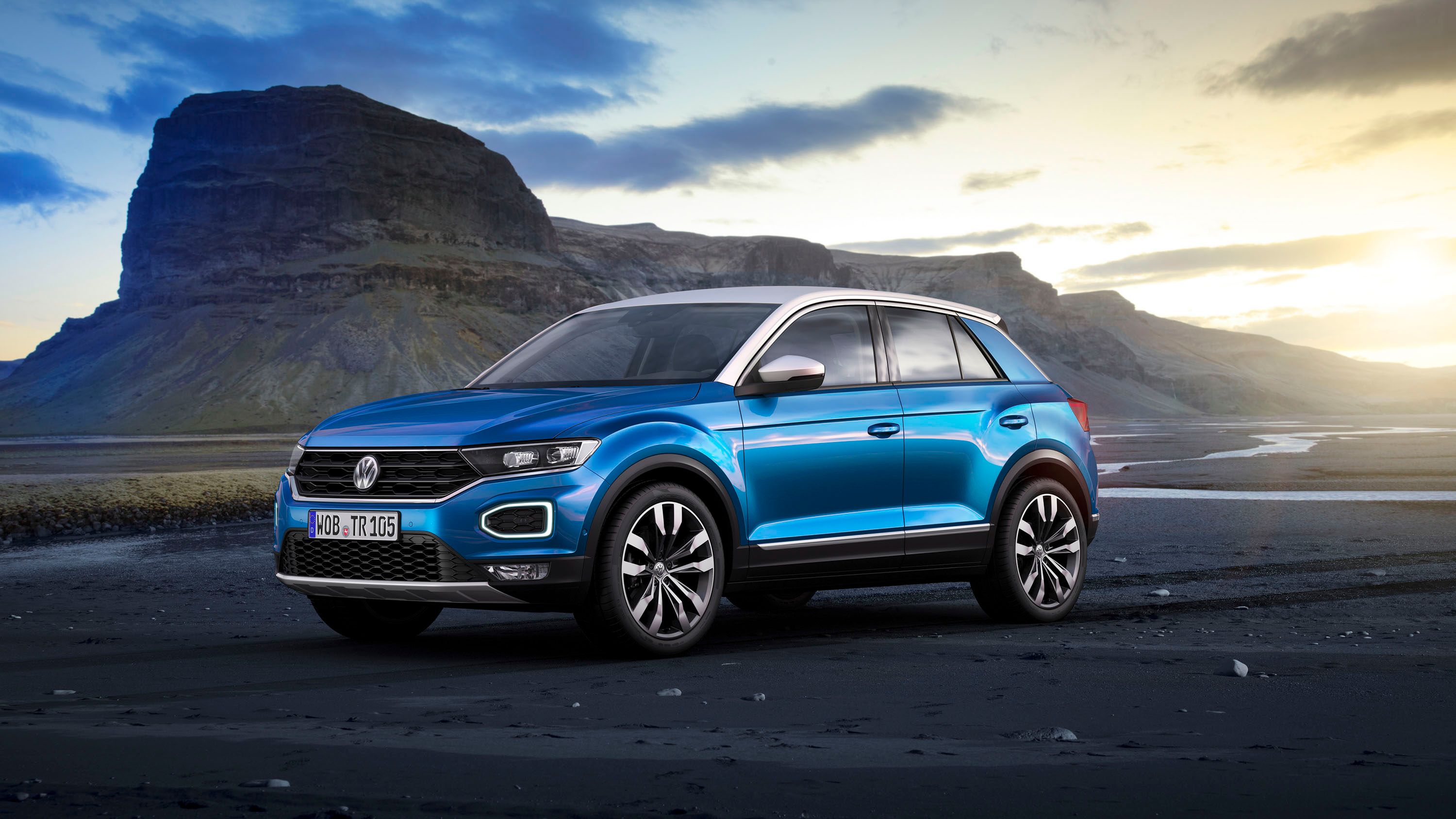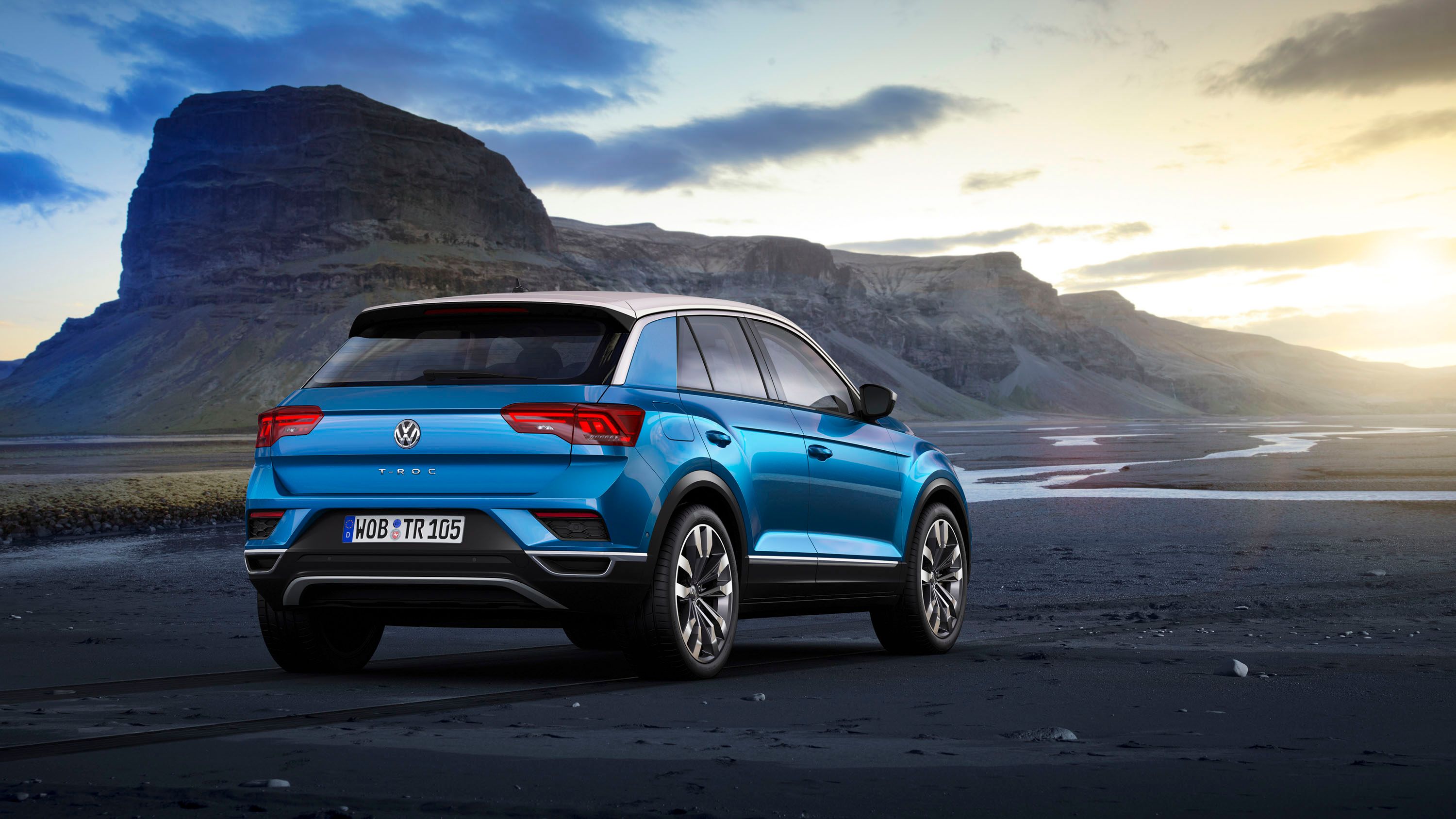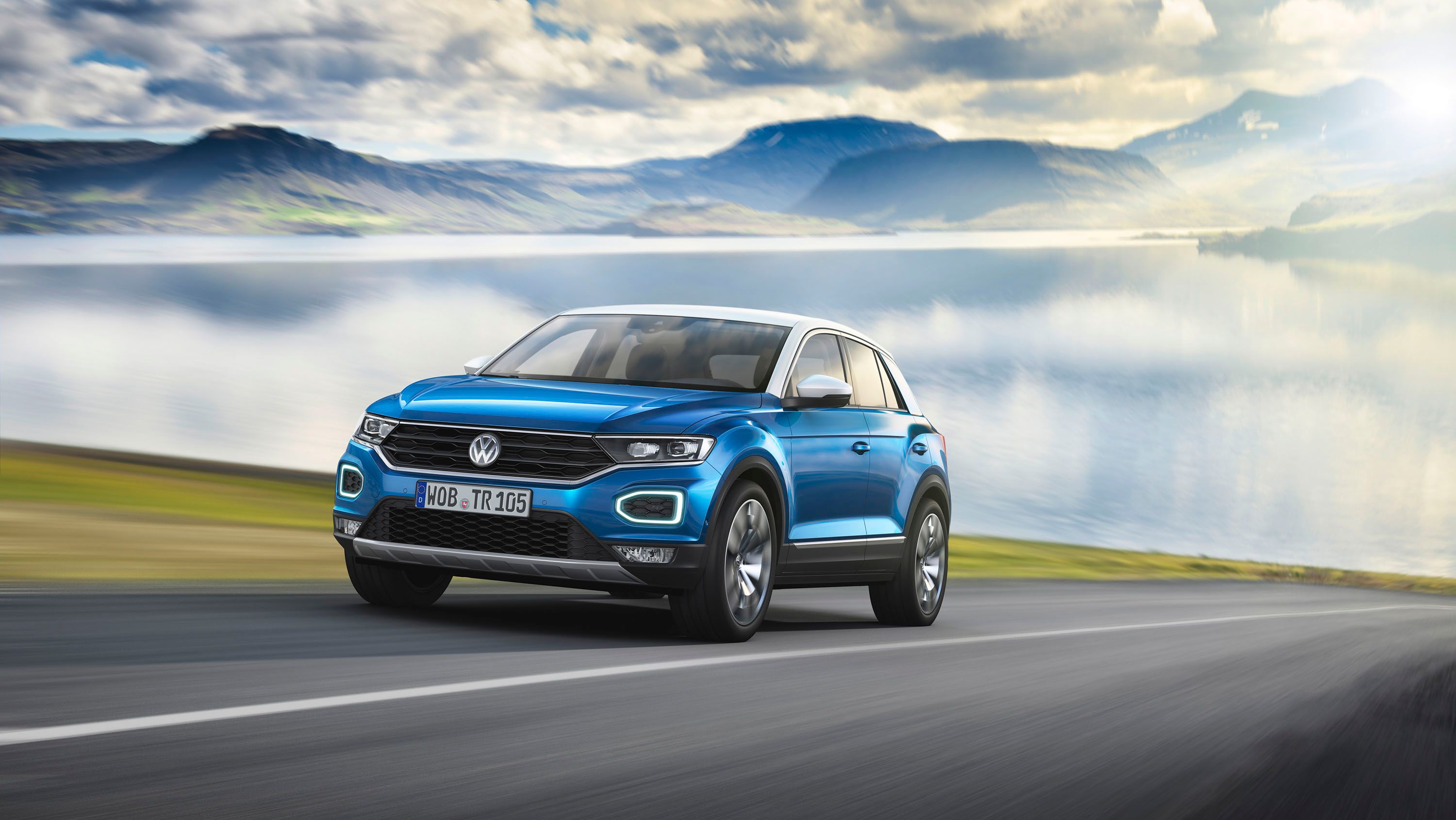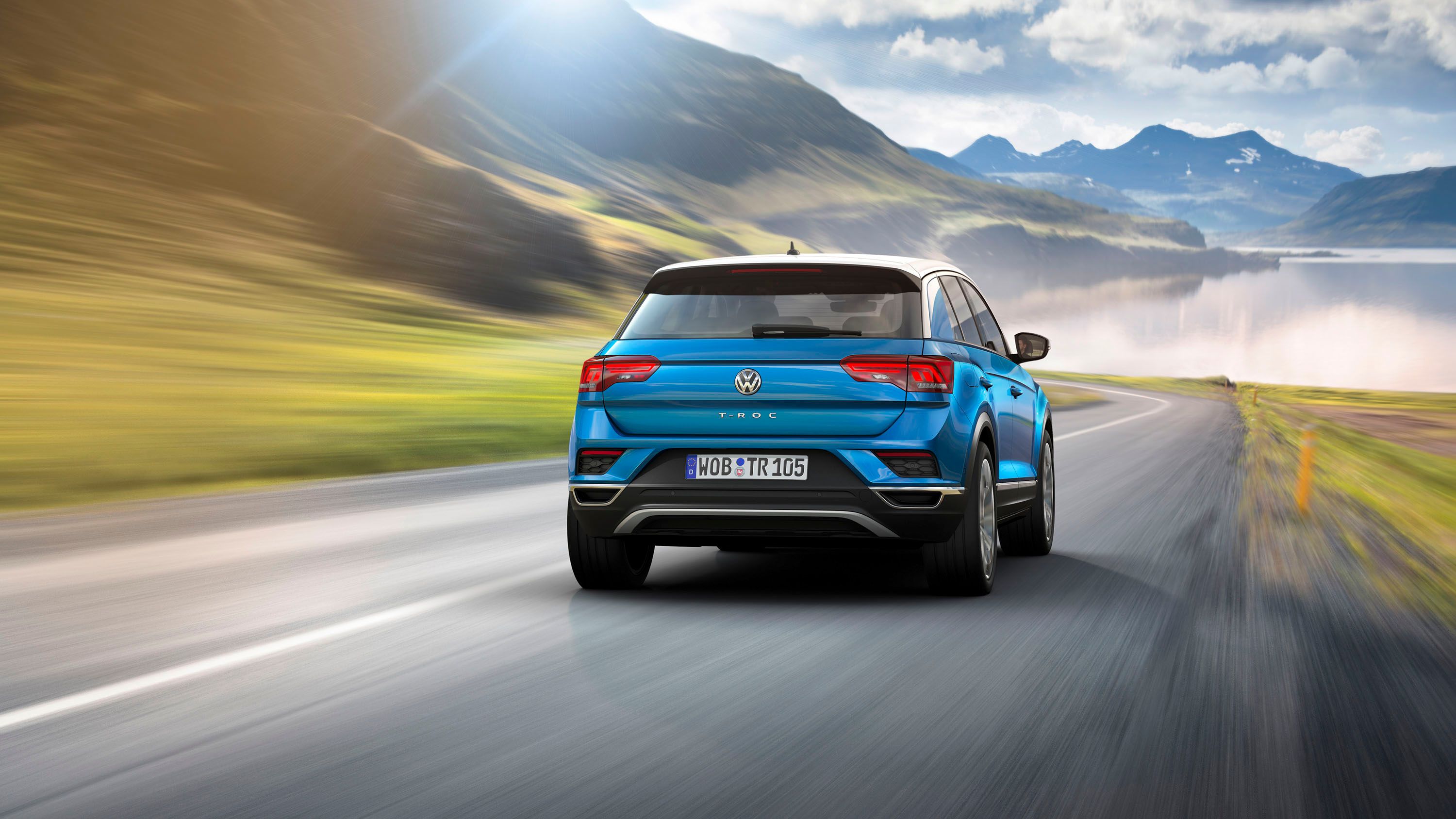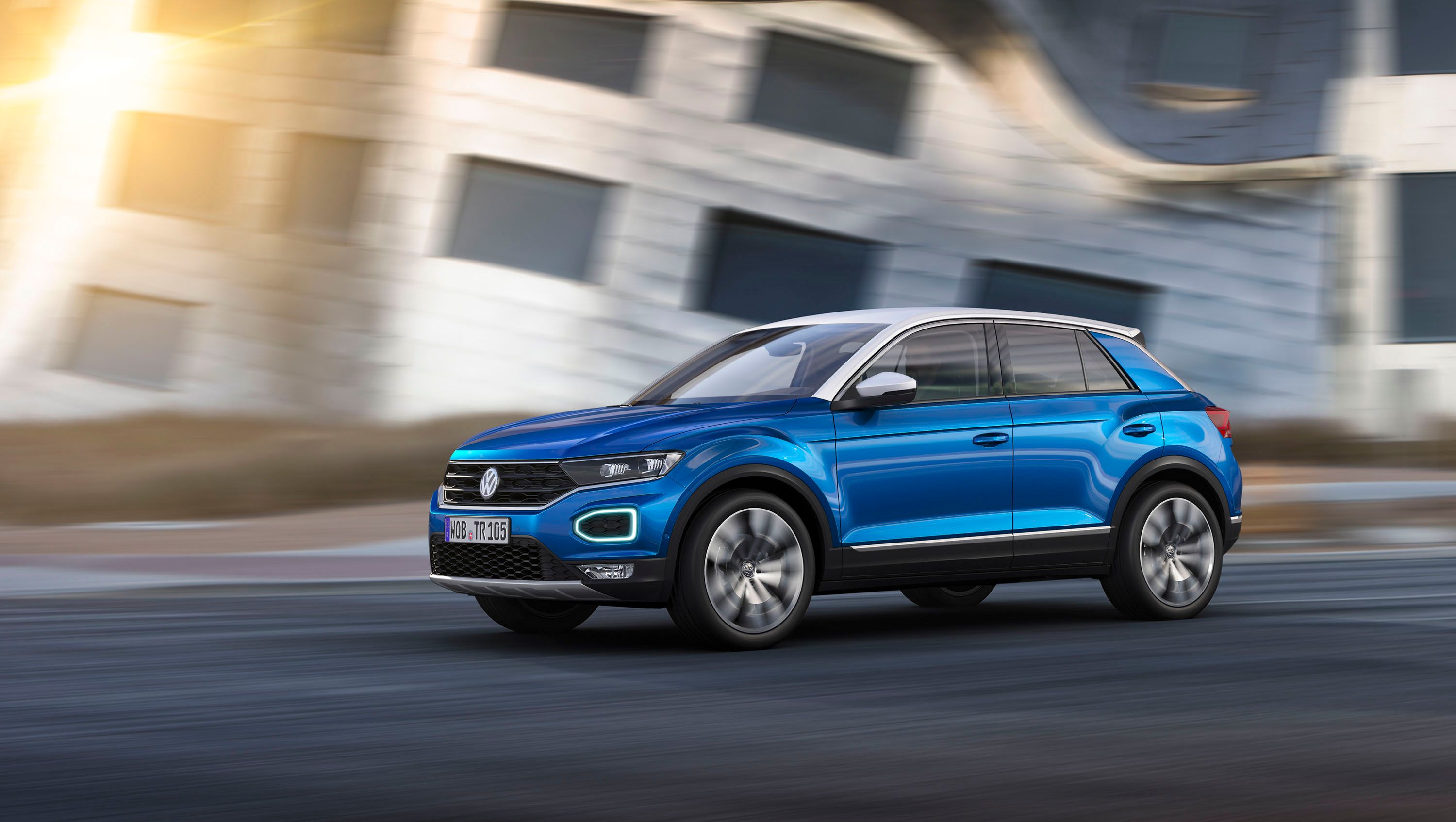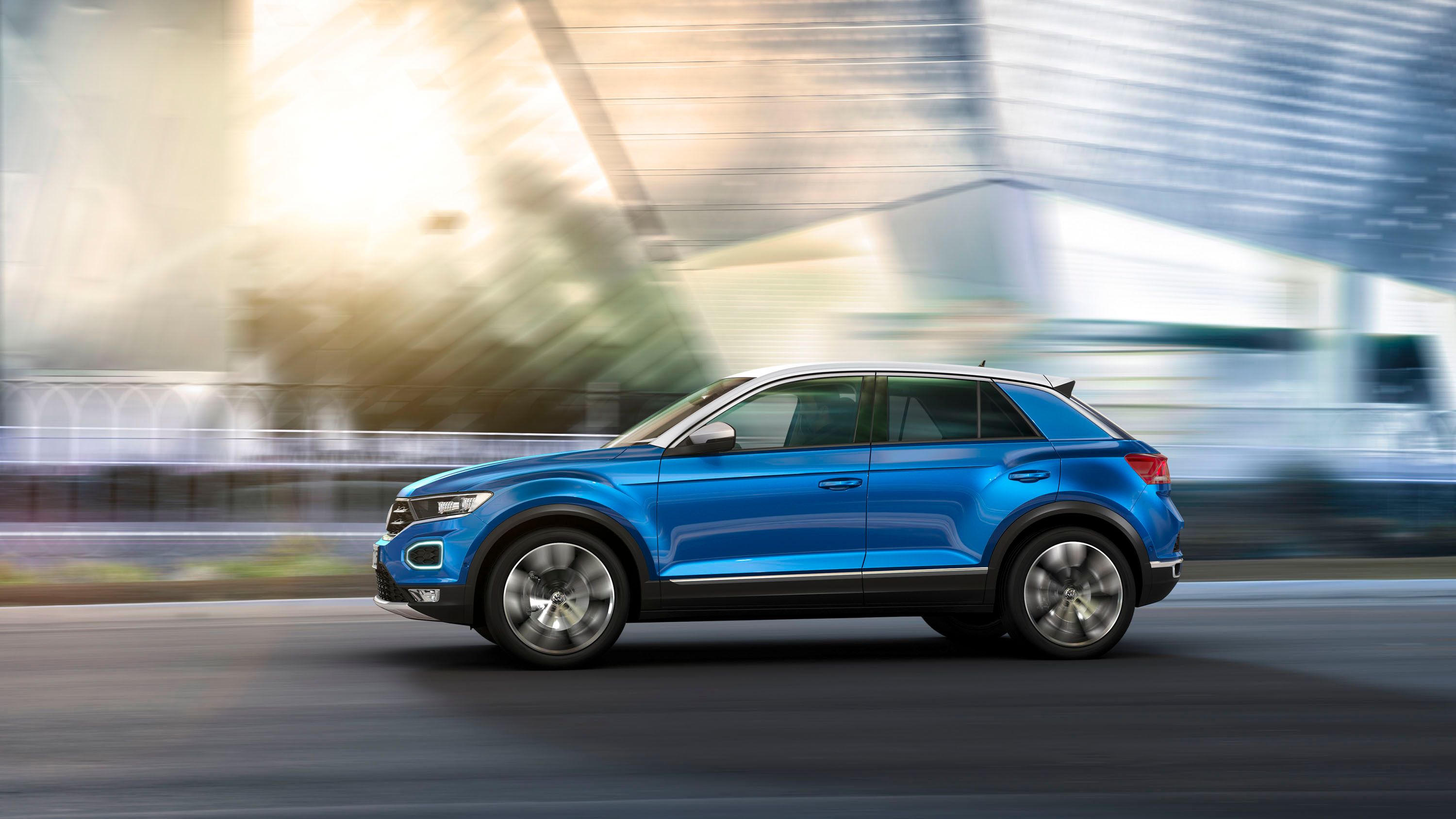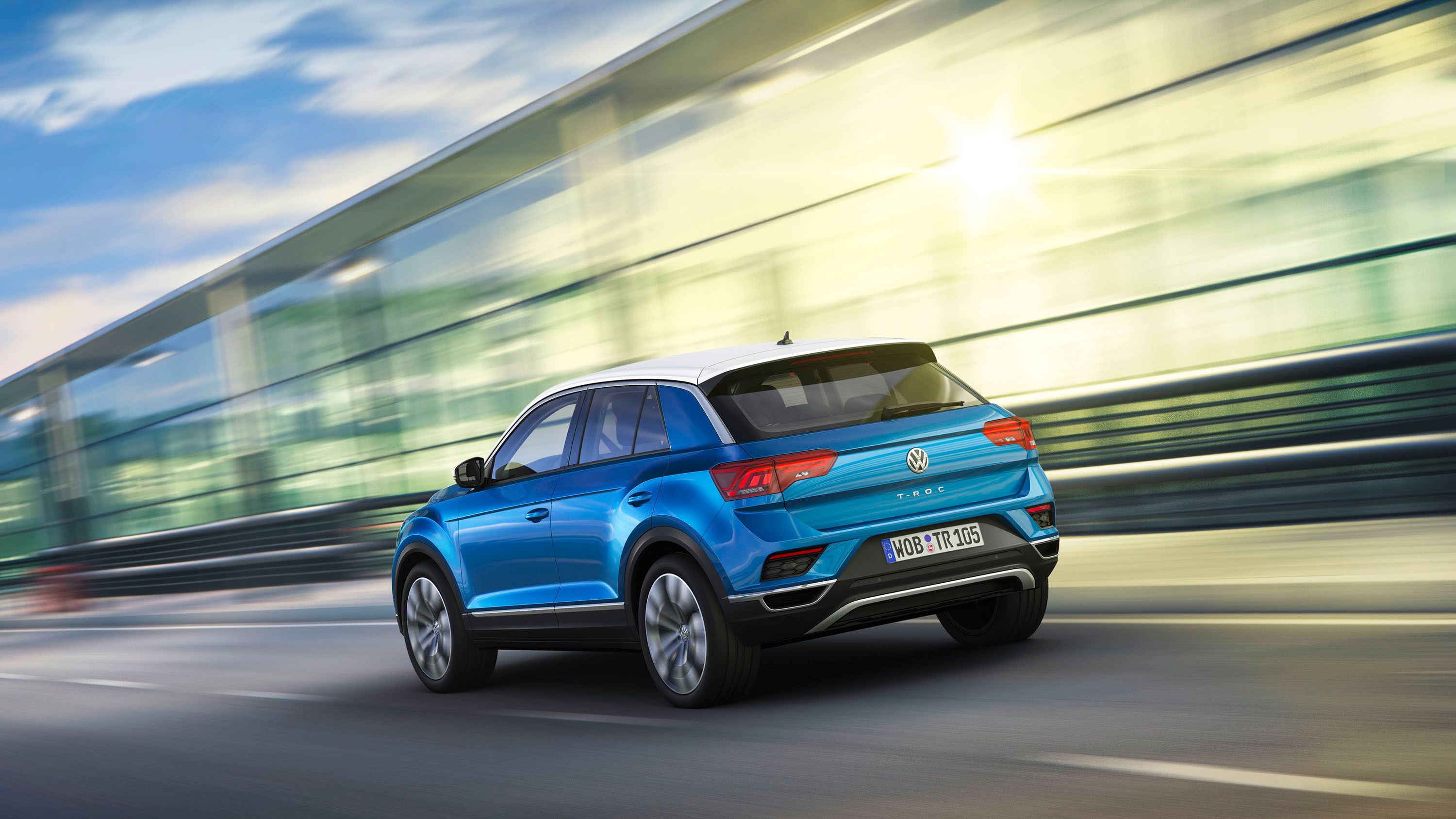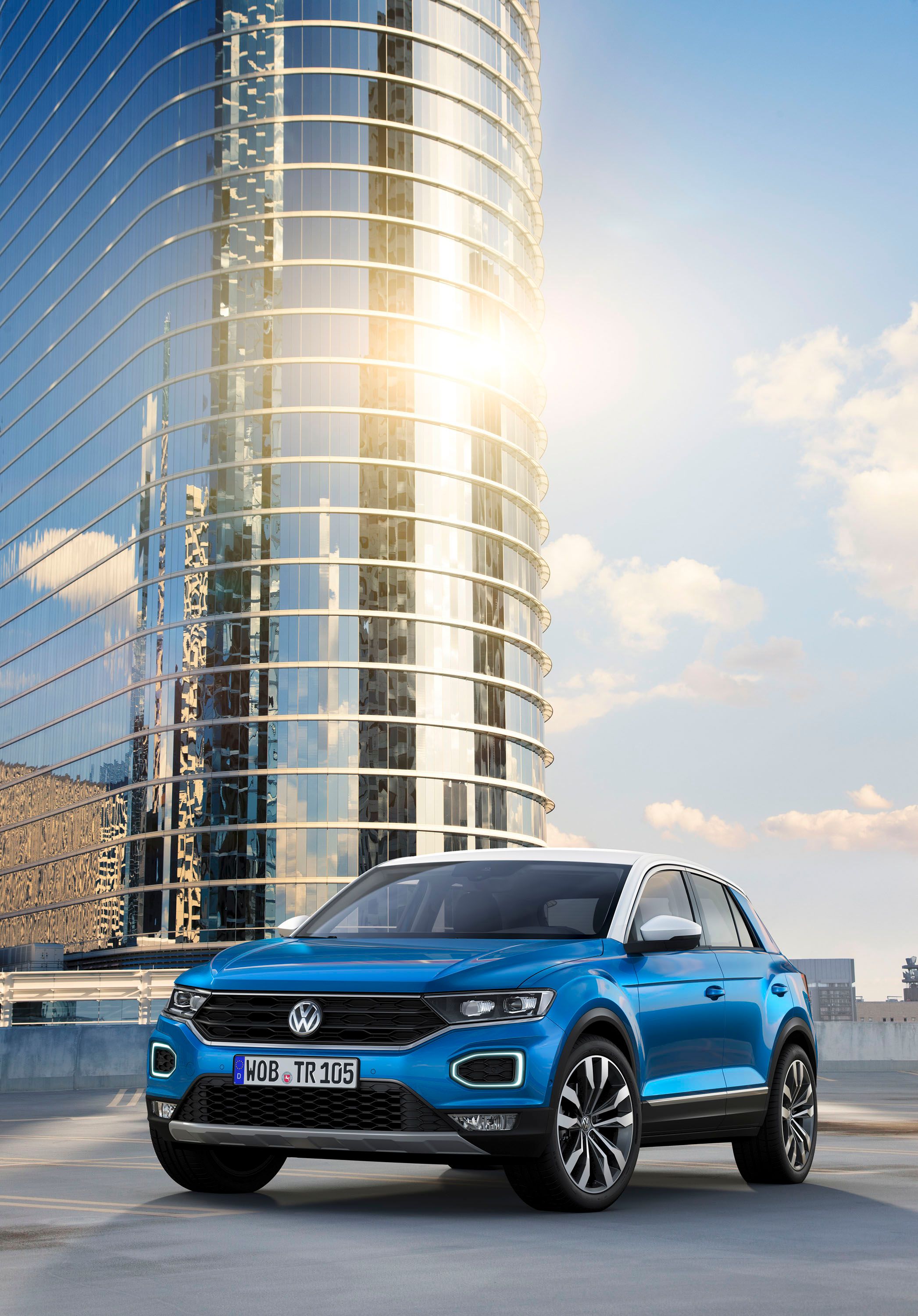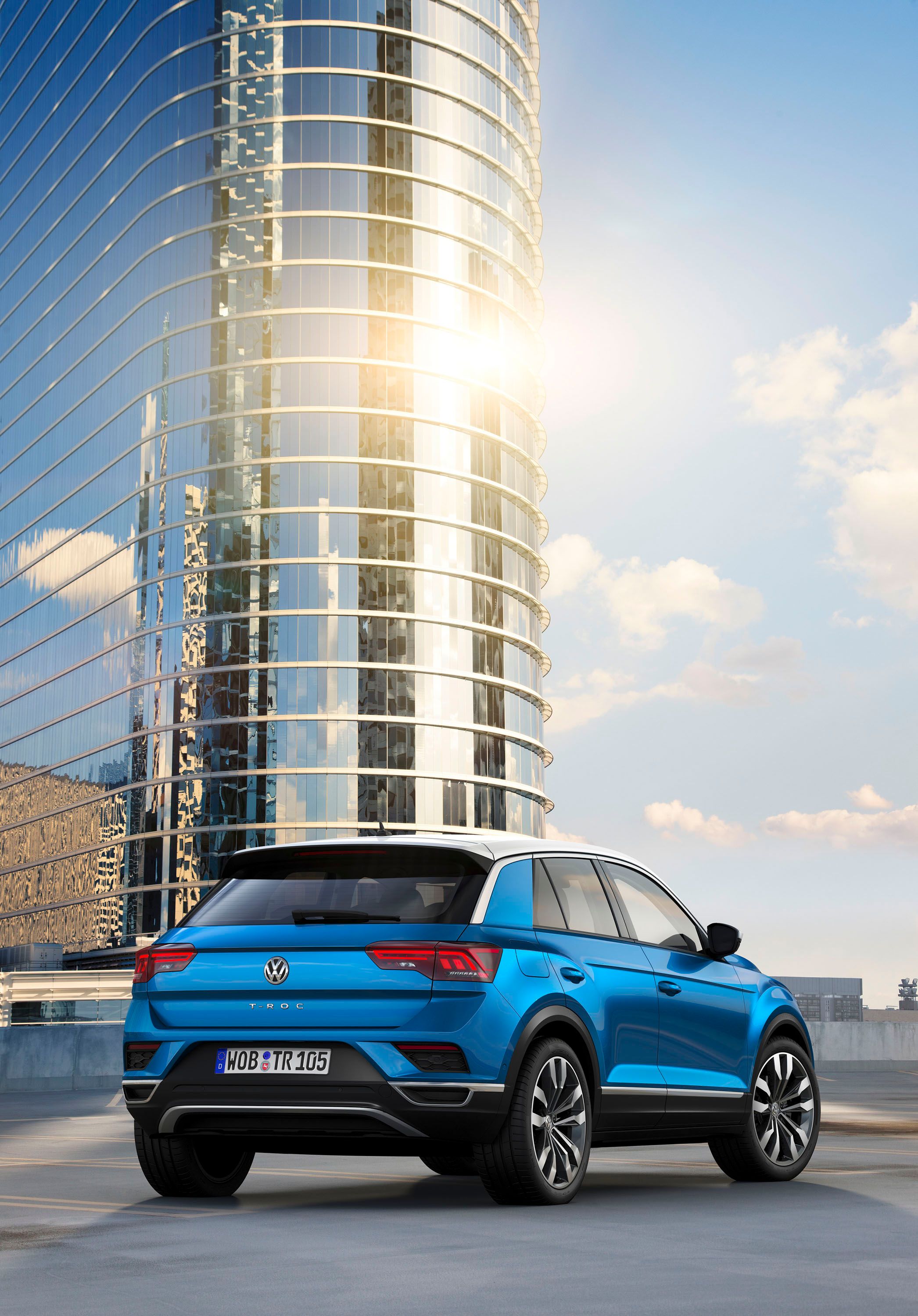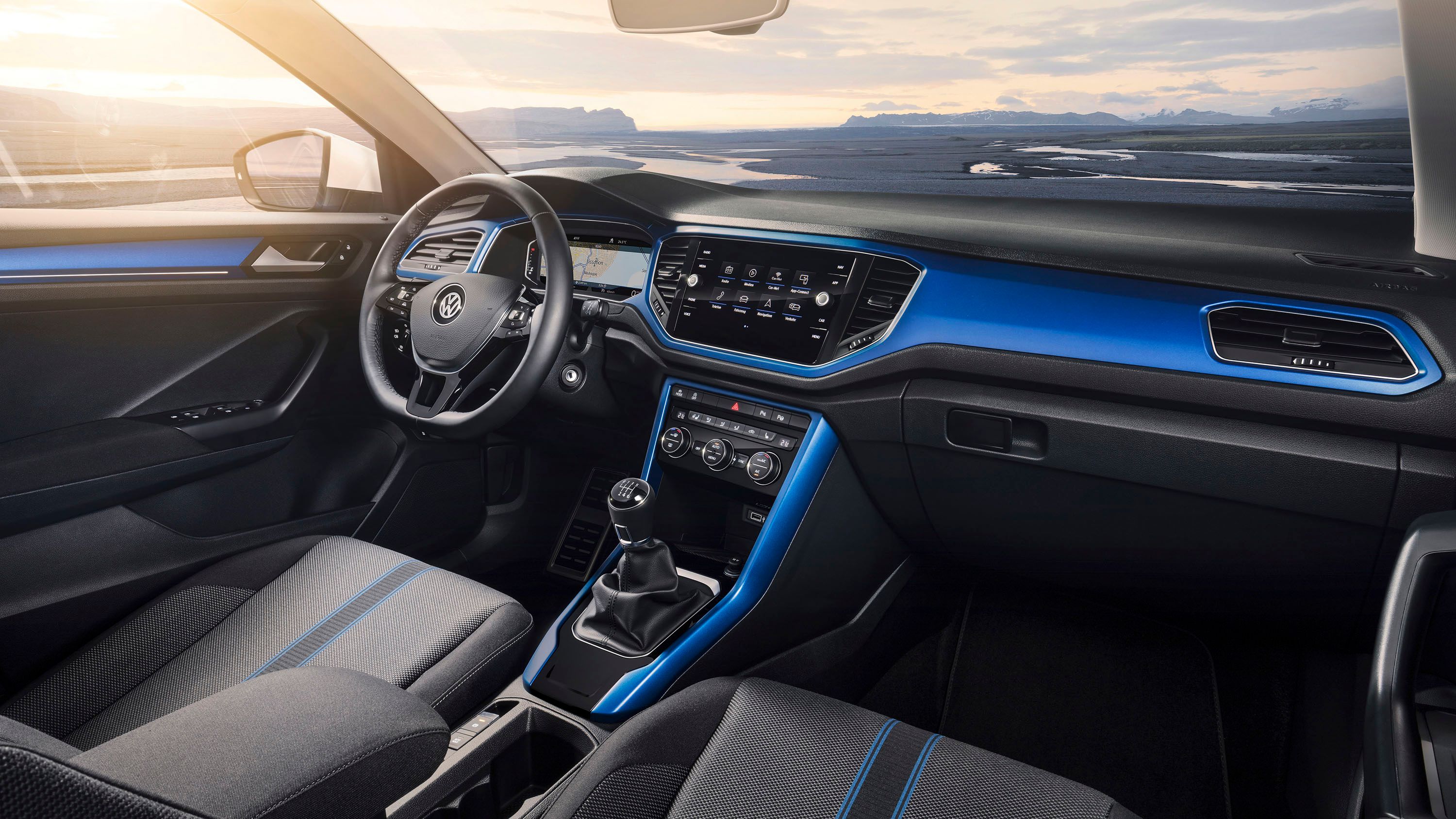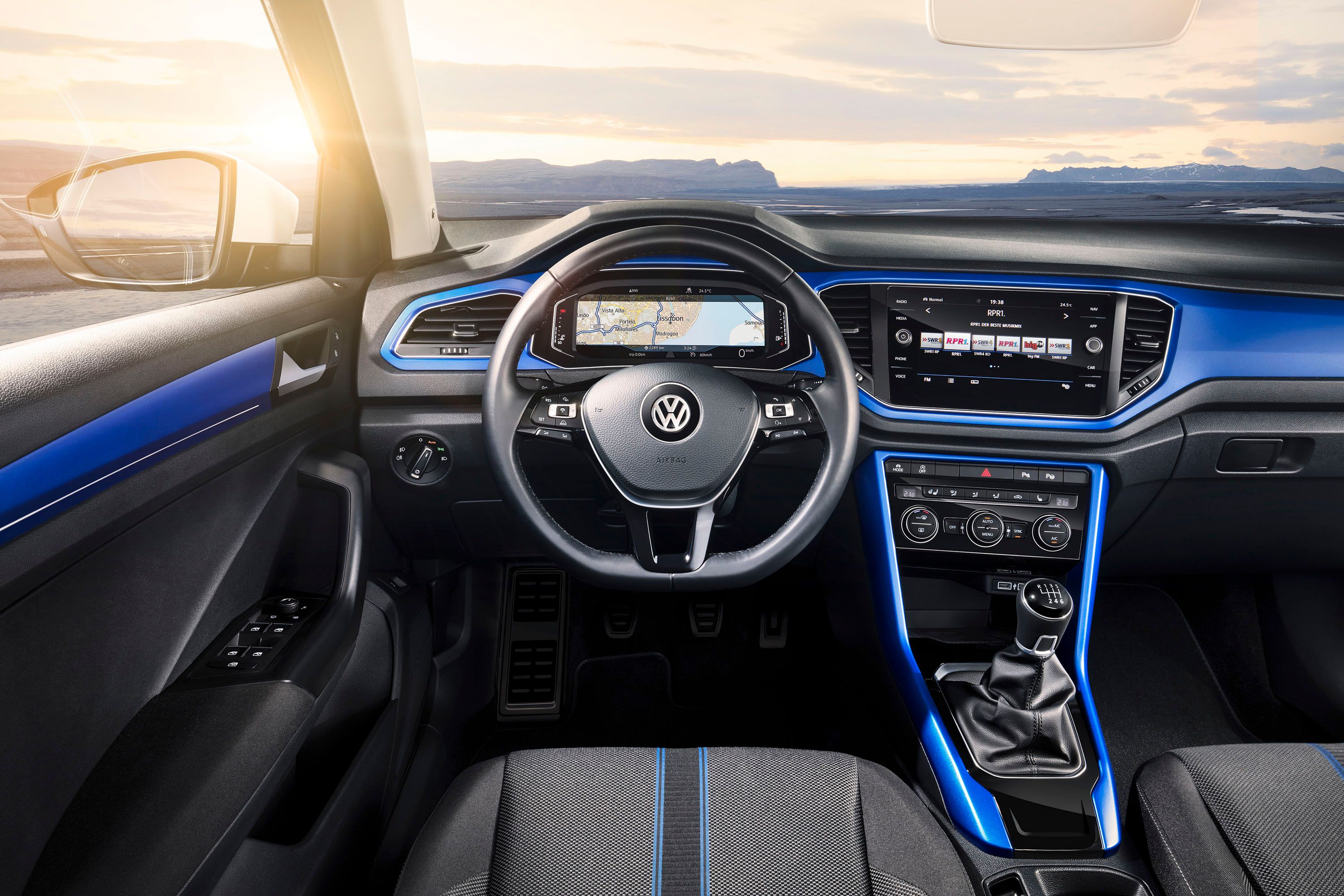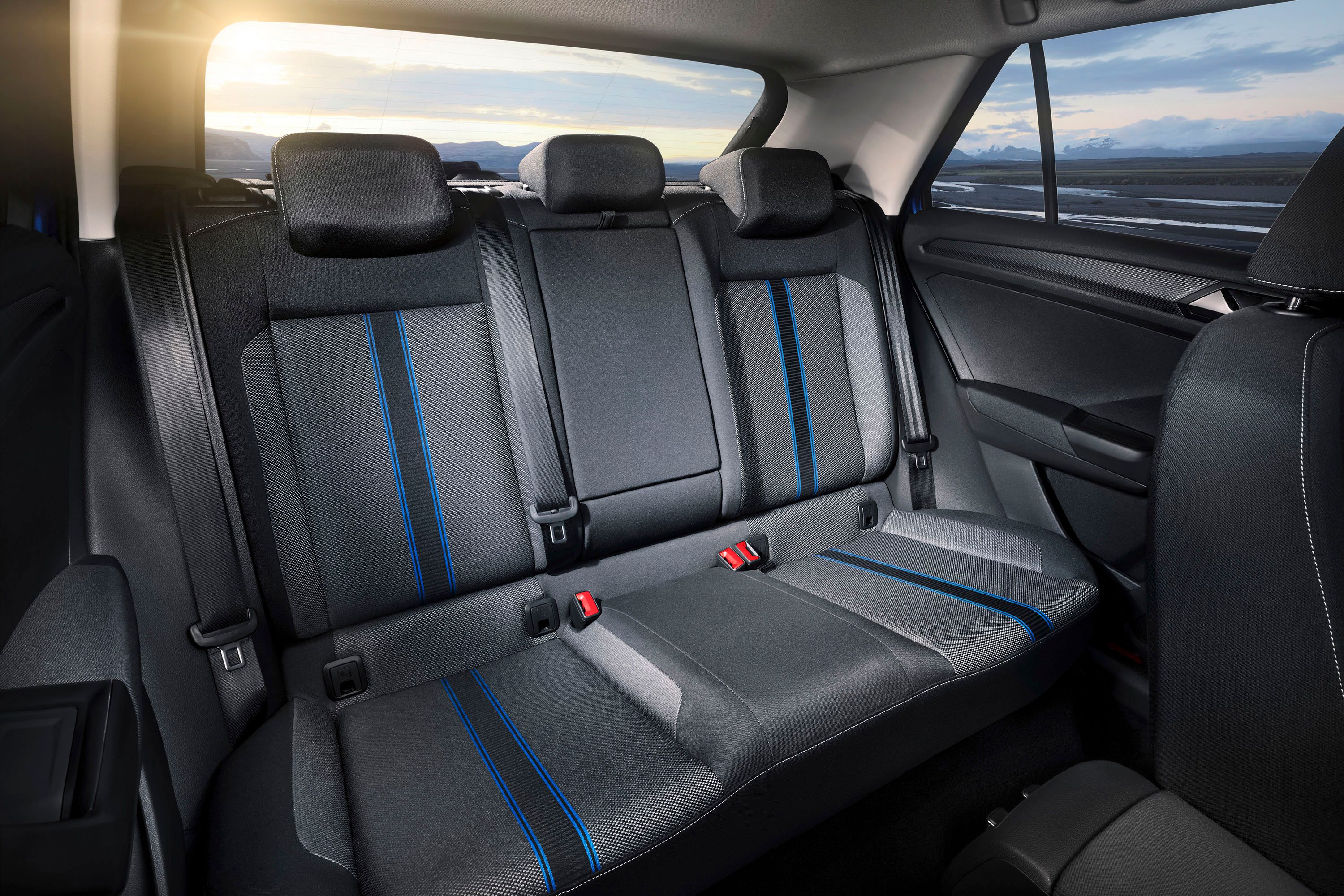Remember back in 2014 when Volkswagen put the T-Roc Concept on display at the Geneva Auto Show? Well, you should, because it was one of the few VW concepts that we could actually appreciate and the one that we really looked forward to seeing in production form. Fast forward to today, and VW has decided to spill the beans on the all-new T-Roc just a month before it’s set to make its first major appearance at the Frankfurt Auto Show. Billed as an innovative compact crossover, the T-Roc boasts a large number of standard features, a sporty exterior design, lots of cargo room for its size, and a massive list of drivetrain options. Driver assistance features fill the list of standards as well, while there are enough options to make the T-Roc customizable to just about any taste, whether your bland and boring or like to stick out like a sore thumb. Three trim lines make up the T-Roc family tree, with the base model offering a good, affordable starting point, while the upper two trim levels – Sport and Style – bring lots of personalization and stand-out options that are exclusive only to those trim levels.
As an all-new model, that we really haven’t known too much about until now, we truly have a lot to talk about. But, you can rest assured that Volkswagen wasn’t playing games or being lazy when it came up with this compact crossover. It’s very well thought out, full of all the goodness that should drive sales and should certainly stand out in the very crowded segment for which it now resides. So, with that said, let’s dive on in and talk all about it – you never know; this just might be your next new car.
2018 Volkswagen T-Roc
- Make: Array
- Model: 2018 Volkswagen T-Roc
- Engine/Motor: inline-3
- Horsepower: 113
- Torque: 147
- Transmission: 6-speed manual
- [do not use] Vehicle Model: Array
Official video
Exterior
If I had to choose one word to describe the T-Roc, it would be “Sharp.” And, it’s exactly that. The exterior is defined by its bold, sharp lines with almost every bend or crease precariously angled just right like the design was simply meant to be. The front grille, while hardly functional, covers nearly the entire nose with its stretched out hexagonal shape that plays into the inner angles of the headlights smoothly. The entire nose is outlined with chrome, but it’s not all one piece, as the Chrome strips in the headlights provide the upward transition and angle back toward the top of the grille – it’s a nice touch, to say the least. Down below, a massive air dam takes up a good majority of the front fascia but, unlike the upper grille, actually supports air pass through into the engine compartment. A pair of concave fake vents sit in the middle corners of that fascia and are outlined with a thick LED strip while a pair of fog light units sit in the lower corners to provide some low-level visibility when things get a little cloudy.
Up higher, the hood displays a pair of thick, curved body lines that elevate from the base where the fenders and A-Pillars meet while a smaller line just to the inside provides a 3D effect on the hood. Massive fender flares make up the front wheel arches and also feature similar body lines follow the contour. While the fender flares don’t lead into the side profile higher up, they do bleed into the concave section at the bottom of the doors, that creates a smooth, recessed rectangle between the front fenders and the rear quarters. To the rear, the rear quarters are far less pronounced and only feature the sharp contour line to go with a mild crease that is in line with the crease that resides above the door handles. Above the waistline, the T-Roc has a completely unique look compared to its larger siblings, the Touareg and the Tiguan. The roof is graded with a slight slant to the rear, while a chrome strip encompasses the top of the doors as well as the upper and rear sides of the C-Pillar.
Unfortunately, the T-Roc doesn’t seem to have that removable roof as seen in the original concept, however, it does prove better functionality with the luggage bars up top. The black trim that traverses across the edges of the roof, and leads into the rather large overhang on the rear hatch matches the body cladding below perfectly and with style. What’s really important to note here is that the C-Pillar is angled strongly toward the front of the vehicle, which means the stationary rear glass on the side is integrated into the door as opposed to the rear quarter. It is shaped like a triangle and does make for a much smaller window if you want the rear windows down, but it looks great from the outside, so it may be a fair tradeoff.
Around back, the T-Roc is kind of two-faced. See if you look straight on, it actually appears as if the rear end is almost vertical. But, that’s just your eyes playing tricks on you because if you look at it from a different angle, you can see the hatchback-like design of the rear hatch:
|
Straight on View |
View from an Angle |
This is unique to most vehicles, especially in the compact segment, and it goes to show how much work VW put into designing the T-Roc form the very start. With that hatchback-like look back here, there’s a lot of attention-grabbing styling cues that really make it stand out. First off, the upper overhang is angled upward just a bit, which casts just a small shadow on the rear glass. The overall width of the car is more evident than ever back here thanks to the sharp lines that run horizontally between the taillights and just below the lights.
The shape of the taillights are fairly common, but the matrix layout inside almost reminds me an old logo from the Forza game series. Down below, the body cladding from the sides gets much taller in the center, providing just enough room on the outsides for a pair of fake vents with integrated reflectors. The exhaust outlets appear to be integrated just below those, as part of the body cladding with a nice chrome garnish on top. Finally, a gray trim accent provides a sporty look that is pretty rare in the compact crossover segment as well.
Exterior Dimensions
|
Wheelbase (Inches) |
102.48 |
|
Length (Inches) |
166.69 |
|
Width (Inches) |
71.61 |
|
Height (Inches) |
61.92 |
|
Track width front/rear (Inches) |
60.86/60.66 |
Interior
The interior of the T-Roc is definitely a big step away from what we normally see in VW production vehicles and obviously very well thought out. Of course, trim accenting like you see here isn’t exactly new – we were doing it long before the automakers decided to, and back then it was at least unique. When it comes to the T-Roc, however, the trim accenting adds a nice touch, and it helps to emphasize just how upscale the cabin really is. I mean, looking at a glance I would almost assume this was a Mercedes cabin just based on the layout and look of the materials. You won’t find as much leather or soft-touch surfaces, but it’s clean with a good fit and finish, and to be honest, probably quite comfortable too.
You really can’t not fall in love with the deliberate lines of the interior – the way the dash is slated just a bit toward the passenger side, the way the overhang above the instrument cluster stands so prominently, the elegant lines that make up all the character of the door trim panels and lower dash. It’s all attractive and a breath of fresh air. And, there’s lots of space too. With the rear seats in the upright position, you get 15.71 cubic-feet (445 liters) of cargo room up to the top of the backrests of the rear seats. Lay down the seatbacks, which can be done in a 60-40 split, and that space more than doubles to 45.55 cubic-feet (1,290 liters.) That’s not class topping, but it comes pretty close.
It’s not all about visual appeal and comfort inside the T-Roc, as there’s plenty of modern technology too. To start off, the base model gets a 6.5-inch infotainment display that is touch-enabled. Moving up to a different trim level or selecting the right option box will get you an eight-inch touchscreen with a CD-Player (sorry no CD player for the base model) while the range-topping model gets the Discover Media, eight-inch system with navigation. Both eight-inch systems offer an all-glass screen like most modern smartphones, tablets, and high-end laptops.
And, ahead of the driver sits an 11.7-inch digital instrument cluster that looks very upscale for this segment. It offers up your basic driver information but can also be used to control your phone and media library separate from the infotainment system (via the controls on the steering wheel, of course.) Meanwhile, if you want to have App Connect services via things like MirroLink, Apple CarPlay, or Android Auto, you’ll need to opt for the larger infotainment systems. You can opt for VW’s security and services package. An inductive charging area is also available ahead of the gear shifter, but you’ll need to opt for the “Comfort” package for this functionality.
Moving up to the upper trim lines will yield you a few extra goodies not found in the base model. First off, the style will give the option to select four trim accent colors along with the comfort seats, driver alert system, and door skins in chrome. You’ll also get reading lights and footwell lighting (should be base equipment in my opinion), and there’s also white ambient lighting with the Style Trim. Move up to the sport, and you’ll get aluminum pedals, red ambient lighting, sport comfort seats, chrome door skins, and a black roof liner. It’s not too bad and does offer up some options for customizing as well. Interior color options for the sport include Caribou Grey while the Style trim gives the option of Black Oak Brown, Ravenna Blue, Energetic Orange Metallic, and Curcuma Yellow Metallic.
Interior Dimensions
|
Seat height front/rear (Inches) |
22.51/24.37 |
|
Cargo space seats up |
15.71 cu ft |
|
Cargo space seats down |
45.55 cu ft |
Drivetrain
As if there wasn’t enough going on outside and inside the new T-Roc, there’s also a lot going on under the metal, with plenty of drivetrain configurations to choose from. If you’re into petrol-drinking motivators, you’ll find yourself deciding between a 1.0-liter, 1.5-liter, or a 2.0-liter. The baby engine is good for just 113 horsepower and 147 pound-feet of torque. This is the base offering, however, so the lack of power shouldn’t be all that surprising or the fact that you’re limited to front-wheel drive and a six-speed manual transmission.
Moving up to a model with the 1.5-liter gasoline mill will net you 147 ponies and 184 pound-feet of twist. It’s not much more, but you do get more configuration options with this engine. In its most basic configuration, you get FWD and a six-speed manual transmission. However, you can also opt for a seven speed DSG gearbox that can be configured as FWD or with VW’s 4Motion permanent all-wheel-drive system. Finally, 2.0-liter comes with a fair 187 horsepower and 236 pound-feet of torque. This engine can only be paired with that seven-speed DSG tranny and comes with AWD as standard.
Now, those gasoline options aren’t too bad, but if you need more torque (not that you’ll be pulling anything too big with a compact crossover, anyway), you’ll need to step up to the TDI lineup that includes a 1.6-liter unit and 2.0-liter unit in two different flavors and five different configurations. The 1.6-liter is the basic diesel offering and is comparable to the 1.0-liter gasoline engine. It offers the same 113 horsepower, but delivers a bit more torque at 184 pound-feet – not surprising for a diesel engine, right? That particular engine is limited to the six-speed manual and FWD, so if you want the DSG or AWD, you need to step up to the 2.0-liter. That TDI can be equipped with either the six-speed manual or seven-speed DSG, with both configurations available in FWD or AWD. In this form, it delivers 147 horsepower and 250 pound-feet of torque – 14 pound-feet more than the range-topping gasoline engine. But, there’s more, as the 2.0-liter is also offered with a bit more power at 187 horsepower and 295 pound-feet. That is the range-topping configuration, however, and can only be had with AWD and a seven-speed DSG.
As far as towing capacity and actual performance specs go, VW has yet to enlighten us, but that’s not generally something that matters much in a compact crossover like this anyway – even if it does look like a sportscar on the inside. As far as 0 to 60 mph goes, expect to see maybe an eight-second sprint at best while towing capacity is likely limited to 1,000 pounds at most, with the range-topping diesel potentially offering as much as 1,500 pounds. Of course, that’s speculation, so take that with a grain of salt until we get official specs when the T-Roc launches.
Petrol engines:
|
1.0 TSI |
113 HP |
147 LB-FT |
6-speed gearbox |
front-wheel drive |
|
1.5 TSI |
147 HP |
184 LB-FT |
6-speed gearbox |
front-wheel drive |
|
1.5 TSI |
147 HP |
184 LB-FT |
7-speed DSG |
front-wheel drive |
|
1.5 TSI |
147 HP |
184 LB-FT |
7-speed DSG |
4MOTION |
|
2.0 TSI |
187 HP |
236 LB-FT |
7-speed DSG |
4MOTION |
Diesel engines:
|
1.6 TDI |
113 HP |
184 LB-FT |
6-speed gearbox |
front-wheel drive |
|
2.0 TDI |
147 HP |
250 LB-FT |
6-speed gearbox |
front-wheel drive |
|
2.0 TDI |
147 HP |
250 LB-FT |
6-speed gearbox |
4MOTION |
|
2.0 TDI |
147 HP |
250 LB-FT |
7-speed DSG |
front-wheel drive |
|
2.0 TDI |
147 HP |
250 LB-FT |
7-speed DSG |
4MOTION |
|
2.0 TDI |
187 HP |
295 LB-FT |
7-speed DSG |
200 4MOTION |
Driver Assistance Systems
Some automakers will make you pay extra for any kind of assistance system, but – fortunately – that isn’t the case with the T-Roc. See, Volkswagen has decided to include some assistance systems as standard equipment. These include City Emergency Braking, Front Assist Monitor with Pedestrian Monitoring, Lane Keep Assist, and Automatic Post-Collision Braking (should an accident actually occur.) With that in mind, there’s also a fairly large list of extra add-ons that you can choose from as well. As far as pricing goes, we’re still unsure, but chances are these systems will be offered up in several different packages. They include the following:
|
Front Assist area monitoring system with Pedestrian Monitoring and City Emergency Braking |
|
Adaptive Cruise Control (ACC) (active from 30 to 210 km/h with manual gearbox, 0 to 210 km/h with DSG) |
|
Dynamic Road Sign Display |
|
Rear View camera system |
|
Lane change system with Rear Traffic Alert |
|
Blind Spot Monitor lane change system |
|
Lane Assist lane keeping system |
|
Park Assist park-steering assistant with the manoeuvre braking function |
|
Traffic Jam Assist |
|
Emergency Assist |
|
Proactive occupant protection system |
|
Driver Alert System |
|
Light Assist main-beam control system |
Pricing
The T-Roc will be VW’s smallest SUV offering and will slot in the lineup below the Tiguan. Based on the current market, where models like the Mazda CX-3, Honda HR-V, Jeep Renegade, Nissan Juke, And Chevy Trax all start out between $19,000 and $21,000, it’s possible that the T-Roc will carry a similar starting price as well. But, VW’s Tiguan currently starts out at $24,995, and this brand is notorious for thinking that it’s more premium than it really is, so a starting price of $22,000 to $23,000 isn’t exactly out of the question either. We’ll have to wait until market launch to know for sure, but until then, I’d say that is a fair estimate.
Competition
Mazda CX-3
If there were two words that could describe Mazda’s smallest hatchback, it would be swoopy and angular, with a big dose of KODO thrown in for good measure. It’s little but sporty, smooth but aggressive – basically, it’s a strong proposition in this segment. The interior is dominated by a less-is-more philosophy with a simple dash and very few buttons. The floating infotainment display looks like it came straight out of Germany while the instrument cluster takes on a three-pod look with a center tachometer.
The CX-3 is available in three trim levels, but unlike other models in Mazda’s lineup, the Touring and Grand Touring models feature the same engine as the entry-level Sport trim. The Mazda’s 2.0-liter four-cylinder is the unit in question, and it delivers 146 horsepower at 6,000 rpm and 146 pound-feet at 2,800 rpm. Front-wheel drive is standard equipment while Mazda’s i-ACTIV AWD system is available as an option. A six-speed automatic handles shifting duties. As of the time of this writing, the CX-3 starts out at $19,960 in Sport trim, $21,960 in Touring form, and $24,990 in Grand Touring form.
Learn more about the Mazda CX-3.
Nissan Juke
The Nissan Juke is a funky little SUV that resides at the very bottom of Nissan’s SUV lineup. Be that as it may, one could argue that it’s also the one with the most heart. It’s been the subject of countless conceptual designs over the last six years and has proven itself as versatile, with the range-topping trims wearing a Nismo badge. It’s sporty on the outside with what has to be the steepest roof slant on any model available while the interior has a bit of a retro feel to it – it’s a nice combination, really. Under the hood, you’ll find a 1.6-liter four-cylinder in all trim levels, with the S, SV, SL, and Nismo trims all come with 188 horsepower and 177 pound-feet of torque on tap. Step up to the range-topping Nismo, and you’ll get a little bit more with 215 horsepower and 210 pound-feet of torque. Pricing starts out at $20,250 for the S trim, $22,550 for the SV, $25,240 for the SL, $24,830 for the Nismo, and $28,020 for the Nismo RS.
Read more about the Nissan Juke.
Conclusion
In conclusion, I have to say I’m pretty pleased with what Volkswagen has done with the T-Roc, and that’s saying a lot as critical as I’ve been of this brand in the past. When the T-Roc Concept debuted, I said “great; another concept that will be slaughtered by the time it gets to the production line.” But, I couldn’t have been more wrong. Unfortunately, it doesn’t have that cool removable roof, but it can be optioned with a huge panoramic glass roof that consists of two panels that open – a fair tradeoff to say the least.
The exterior design is provocative and engaging while the interior is nothing short of a work of art. To be honest, that interior - -at least in the upper trim levels, anyway – reminds me of something you would find in the Mercedes-AMG A43 or the BMW M3 competition. It’s certainly a step above its pay grade, even without soft touch surfaces and Alcantara. Now, Volkswagen needs to bite the bullet, come up with an “R” version that delivers 420 horsepower, and has all of that extra Alcantara and Leather – now that would be something to see. If Mercedes and BMW can sell a $30,000 for $60,000 by adding more power and extra goodies, so could Volkswagen. Wait… did I really just say that about a Volkswagen? Yes, I did. That’s pretty amazing.
But, what do all of our loyal readers thing about the new T-Roc? Go ahead and tear up the comments section below and I promise I’ll try to reply.
References
Read our full review on the 2014 Volkswagen T-Roc Concept.
Read our full review on the 2017 Volkswagen Tiguan.
Read our full review on the 2017 Volkswagen Touareg.
Update History
Live Unveiling
Pre-Debut Teaser
The Volkswagen T-Roc, a production model that’s based on the 2014 T-Roc Concept, is set to make its debut at the 2017 Frankfurt Auto Show. So far we’ve seen some pretty amazing spy shots of VW’s new mini people hualer, all of which showed a car that lacked any Camo, so we already know what to expect. Be that as it may, VW decided to release a “teaser.” If you’re wondering why I put an emphasis on the word “teaser,” it’s because it’s not much of a teaser at all. I mean just look at it – it’s a sketch that vaguely resembles the car we’ve seen testing in all its glory just a few months ago.
With that said, however, the teaser isn’t without its merits as it could lead some hints toward the final production design, and that means we could see something different than what we’ve already seen thus far. Notice how the grille is as dominant as it was in the most recent spy shots? Or, how about those vents in the corner that now feature a full trim insert all of the way around? The mirrors are sleeker by far, while it looks like the production version may be one of the first cars in this niche to sport automatic door poppers since there are no door handles to speak of. The other really noticeable thing is the way the windshield wraps around to the top of the roof, exposing the possibility that this little SUV could have a massive glass roof, a perfect feature for those who ride at night.
As you can see, the headlights have a pair of angular LED strips while the windows are frameless for the most part. Whether or not this type of design is feasible outside of a sketch remains to be seen, but it could lead to a pretty sleek looking SUV. Oh, and in case you don’t know how this works, don’t expect to see those massive wheels and extra-wide tires on the production model – that’s just something to grab your attention for now. If you want 28s on your whip, you’ll have to hit up your local rim dealer and pony up for them ;)
So, what do you guys think of the teaser or the spy shots you can see below? Let us know in the comments section and check back soon for more updates and we approach the T-Roc’s official debut.
Like a Crystal Ball, we can See the Future
So, most teasers give us very little to go by, and I have to say that the previous teaser was a complete let down considering we had already seen the T-Roc testing in public while being butt naked. But, it has been a week, and this time around we get two more sketches (seen above) and a video that gives us a real look at what to expect. First off, let’s talk about what we can see from the outside. The biggest thing that caught my eye right away is the massive chrome trim that runs along the top of the side glass and extends further back to garnish the side of the hatch glass in the rear. It’s a nice touch, but from the right angle it kind of looks like a thin, chrome hockey stick, so there’s that.
We also get a nice view of a majority of the rear end, including our first look at the official taillights, which include a unique matrix layout that for some reason reminds me of the Forza Motorsports logo. It is, of course, different, but it’s got a similar layout. The taillights feature rounded corners with sharp lines elsewhere and a jagged bottom edge that shoots upward a bit just past the seam for the rear hatch. Outside of this, the rear end is very well defined with deliberate lines everywhere that make the model shown in this video much more attractive than the mule we saw testing earlier this year. Eventually, the video pans to a shot of the wheel and the rearmost portion of the side skirts. The wheels are quite attractive and feature a five, dual-spoke design. The side skirts feature protective body cladding, but VW put in the effort to keep things glassing with some nice chrome garnishing and a sharp line that outlines the wheel wells and side skirts – Nice!
Finally, the camera pans to the front end. We don’t get to see the whole thing, but boy are things different between this model and the mule we saw a while back. Where the mule had a grille that was outlined in chrome that also matched the trim in the corners around those fake vents, this (assumingly) production model has changed quite a bit. The headlights are much more rectangular and don’t feature that bubbled look – much like the sleek headlights of the T-Roc concept. The lights inside look to be dual LED units, so that’s a plus, but more importantly is the change of pace from LEDs being mounted inside the lights. Instead, the lights are bare aside from a thin chrome strip at top that carries over from the top of the grille. The lower chrome garnishing travels from the grille and continues below the headlight all the way to the corner – a much cleaner look compared to the mule we saw before and similar to the design of the original concept. Down below, tacky chrome garnishing has been removed from the fake vents, which have now be outlined with a bright LED strip that not only highlights the unique shape here but also provides excellent visibility to oncoming traffic. For once, I might not have to be so critical of VW’s exterior design language, but I’m still not holding my breath.
Now, before we sign off from this update, I want to point out that we get a quick glimpse of the interior too, and this is the first time we’ve seen any interior shot of the T-roc since the concept debuted. Of course, we don’t get to see much, but we can see that at least some of the concept’s design carried over. First, check out the colored inserts at the top of the door panel. These don’t travel all of the way around the door handles but have been reduced a bit and look quite stylish. The same thing goes for the dash. The insert isn’t nearly as tall, residing only on the frontal face of the dash, but it does surround the HVAC vents in the corners. The lines are very thought out and deliberate, and the interior has a very angular look to it. The basic shape of the dash seems to have carried over from the concept as well. Toward the end of the video, we get a quick glance through the driver’s window that gives us a better view of the upper door trim panel, which does feature a thin chrome strip. The other noticeable thing here is that the infotainment display is integrated flush with the center stack instead of sitting upright like the tablet-looking display in the concept. All told, the T-Roc should be wildly different from the rest of VW’s products and should be quite surprising when it finally makes its debut. Let us know what you think in the comments section below!
Update 8/16/2017: Volkswagen has released more teasers prior to its debut! There’s a sketch of the T-Roc’s rear end and another sketch of the side profile to go with a new video that gives us our first official glimpse at the interior and exterior. Check out the teaser section below for the details.
Update 08/10/2017: Volkswagen has released its first teaser up the upcoming T-Roc in the form of a sketch. Check it out for yourself in the special teaser section below.


